
…The worst time to respond to a drought is in the midst of one.
At that point, there are few, if any, good options available to avoid the worst impacts of drought, and combined with enflamed passions and politics, reaching consensus on solutions is nearly impossible.
We need to start planning for future droughts so that we have more options available to us when the next drought hits and we are less likely to suffer significant economic or ecological harm.
The Nature Conservancy and others, open letter to US Senate, 5 October 2015
Introduction
As populations increase and incomes rise, patterns of consumption shift to a demand for products and services with greater water footprints. In the absence of improved management, water resources are increasingly likely to become a source of tension; a tension that will be at its highest during periods of drought (Figure A).
Figure A. Significant future challenges demand a change in approach
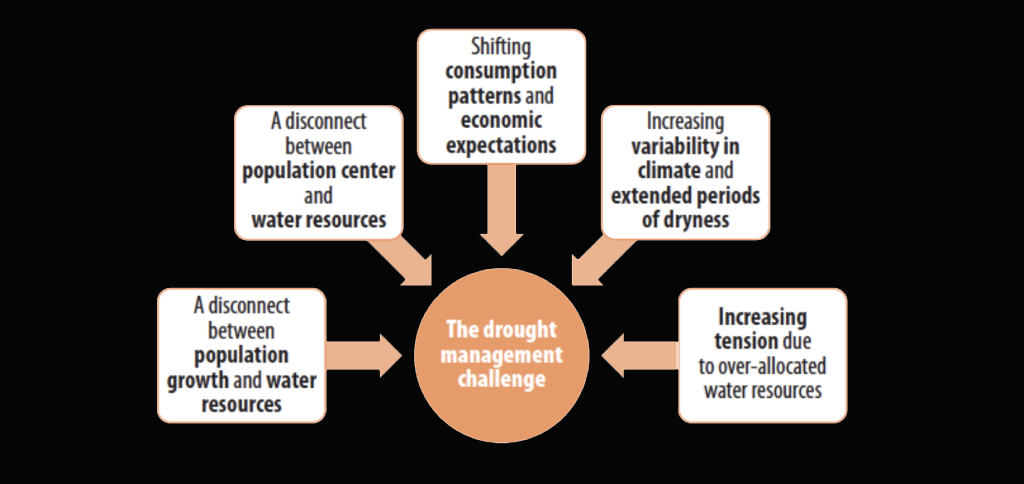
Current approaches
Why are current approaches inadequate?
The inadequacy of current drought management practice, as observed through the continued impacts of droughts, underpins a consensus that a transformational change in approach is required – away from an episodic process that reacts to an emergency to a continuous process that proactively manages risk. Although some progress has been made, the transition to a more strategic and risk-based approach to drought management is only in its infancy. There are a number of reasons for this slow progress including, for example:
Ambiguity in the terminology of ‘drought’ hampers communication and often conflates hazard and impact
Failure to recognise drought as an extreme event
Reliance on historical analogues
Failure to recognise the interdependencies between freshwater ecosystems and the well-being of human systems (as illustrated in Figure B).
Figure B. Freshwater ecosystems and human systems are interdependent; failure to recognise this linkage undermines current efforts to manage droughts and their impacts
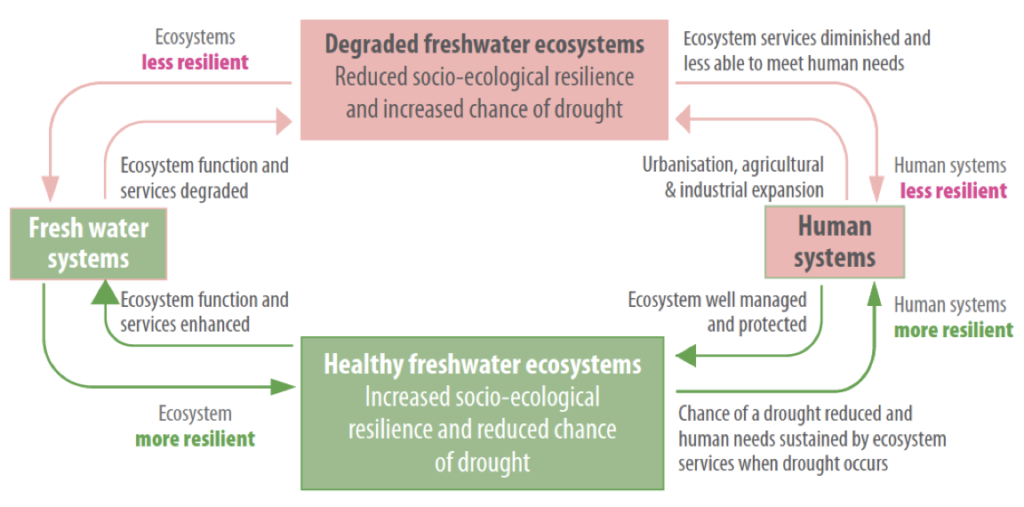
What are the issues and challenges to overcome?
Drought management practice has primarily evolved in response to drought events. It has also been influenced by advances in science and philosophy such as ecosystem based approaches and adaptation planning, practices in other sectors such as integrated water resources management and disaster risk reduction. Yet no single blueprint for good drought management has emerged. There is, however, consensus over the challenges still faced by modern drought managers. The most important of these challenges are summarised in Figure C.
Figure C. Summary of issues and challenges facing international practice

Strategic Drought Risk Management (SDRM)
Strategic Drought Risk Management (SDRM) is the process of data and information gathering; risk
analysis and evaluation; appraisal of options; and making, implementing, and reviewing decisions to reduce, control, accept, or redistribute drought risks. It is a continuous process of analysis, adjustment and adaptation of policies and actions to reduce drought risk, including modifying the probability of a drought and reducing the vulnerability and enhancing the resilience of the receptors threatened. SDRM forms part of the wider approach to water security and water-related basin planning and allocation activities. It focuses on delivering a drought-resilient society by reducing drought risks and promoting environmental, societal and economic opportunities now and in the longer term. It recognises that risks can never be removed entirely and that reducing risk may be at the expense of other societal goals.
A modern definition of drought
The traditional classification of drought types has evolved primarily from the meteorological and hydrological sciences (meteorological and hydrological droughts) to reflecting agricultural and socio-economic impacts. Today, a myriad of drought types exist with few accepted definitions.
This report proposes definitions that more explicitly distinguish different aspects of the ‘hazard’ (Figure D):
A meteorological drought (hazard) is defined here as: a temporary, negative and severe deviation from the average precipitation values for a significant period of time across a river basin or region.
A blue-water drought (hazard) is defined here as: an unusual and significant deficiency of groundwater, stream flow, or lake storage.
A green-water drought (hazard) is defined here as: an unusual and significant deficiency in water stored in or on top of the soil or vegetation.
Drought risk is defined here as: an emergent property of the human and natural system, reflecting the interaction between climate (meteorological drought), the hydrological response of the basin (blue-water drought and green-water drought) and the vulnerability of the people, ecosystems and economies exposed to it. Drought risk reflects two components: the chance that a drought hazard will occur and the magnitude of the associated impacts.’
Figure D. Classification of drought types and associated impacts
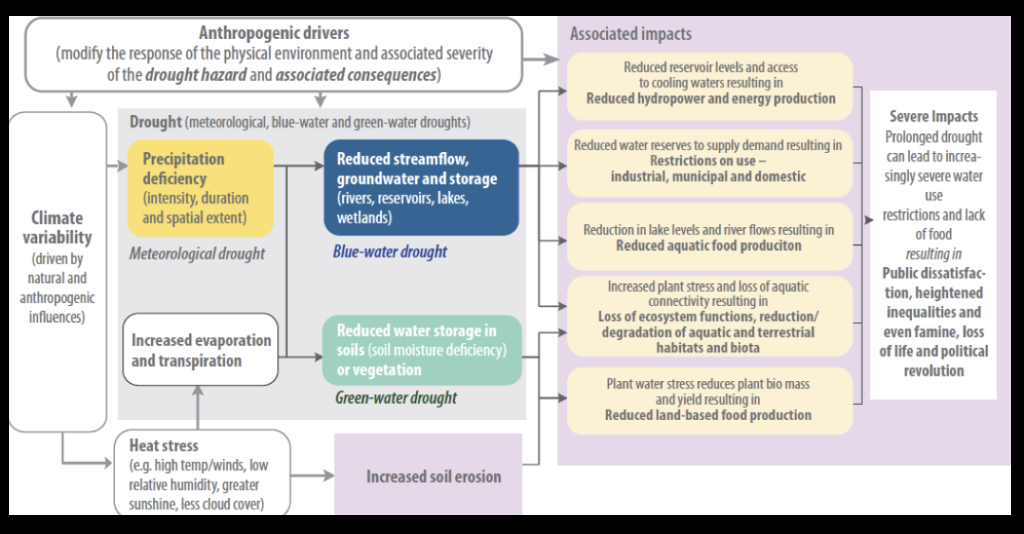
Role of Strategic Drought Risk Management
The overarching role of SDRM is to develop a drought-resilient society so that during drought individual needs and ecosystem services are safeguarded and economic impacts minimised.
A drought-resilient society requires more than preparing for drought with physical infrastructure or responding to drought by motivating communities. It involves delivering multiple outcomes for people, freshwater ecosystems and economies to embed drought resilience in all sectors of society.
Components of a strategic drought management plan
A drought resilient society develops a new relationship with water – one that recognises the mutual dependence between human development and freshwater ecosystems.
This is an ambitious goal that requires society to consider drought risk alongside broader water resource and development issues and to adopt ongoing learning and adaptation.
Achieving this transition needs a political understanding and acceptance of drought risks, widespread awareness of those risks and momentum to implement a portfolio of measures to
reduce or remove risks (Figure E).
Figure E. The framework of Strategic Drought Risk Management
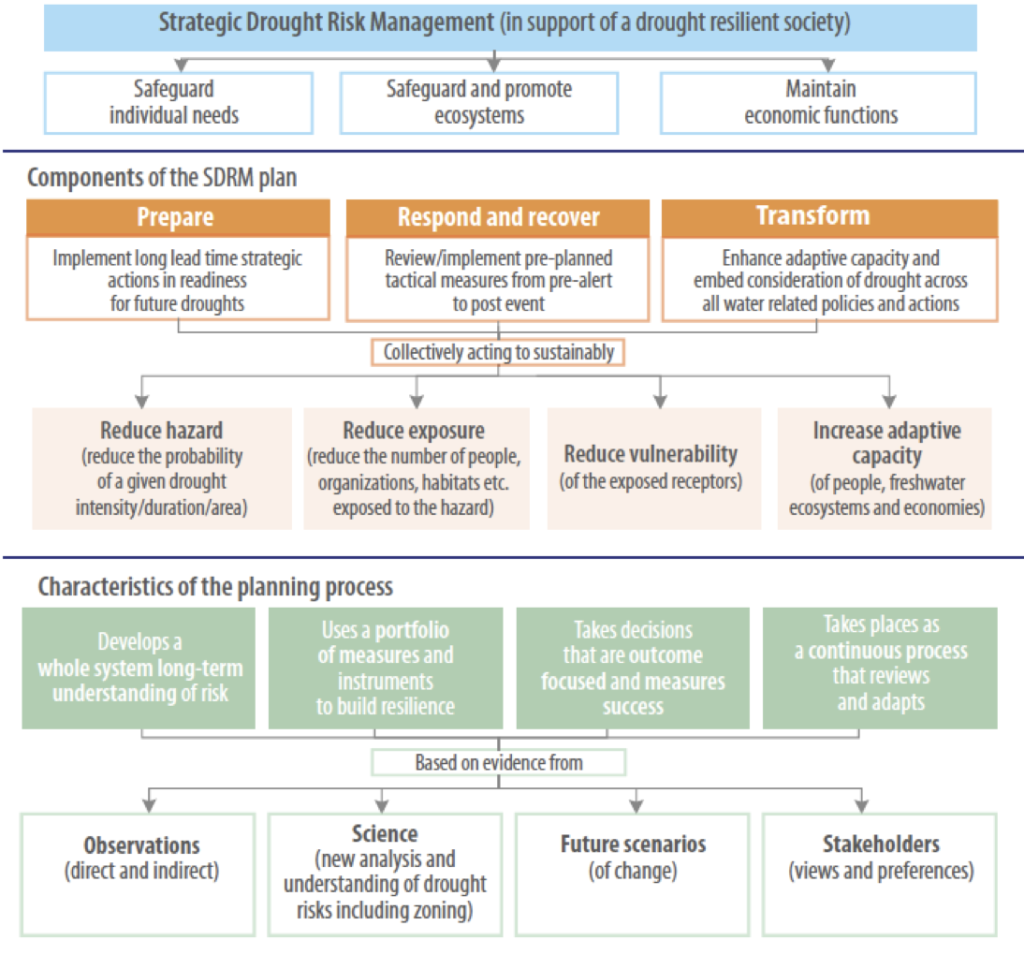
A portfolio of measures and instruments to manage drought risk
SDRM involves taking a long-term approach to managing risk using a portfolio of measures (Figure F) to:
- Establish appropriate systems for water allocations and entitlements
- Develop a supply–demand surplus and redundance
- Enable a better response and faster recovery
- Promote a sustainable water future
- Establish credible mapping, monitoring and forecasting services.
Figure F. Typical considerations in developing a portfolio approach to Strategic Drought Risk Management
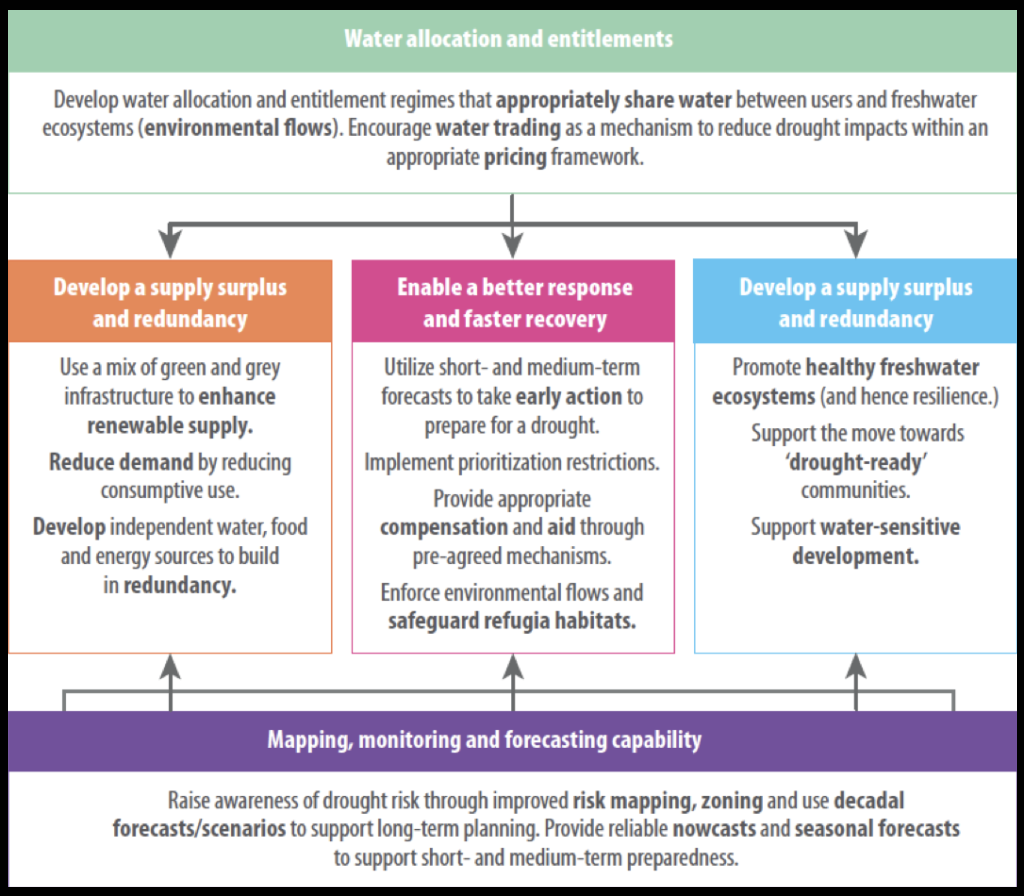
Safeguarding and enhancing freshwater ecosystems through Strategic Drought Risk Management
Ecosystems provide critical provisioning, regulating, cultural and supporting services. Drought management choices can have a devastating impact if safeguarding these services and working with natural processes is not taken into account early in the management process. A shift in emphasis is required to safeguard and promote ecosystems through SDRM, making working with natural processes a central consideration. As river basins become increasingly water scarce and degraded by pollution and other impacts, their sensitivity to variability in precipitation, and their vulnerability to drought, is likely to increase. Table A summarises ecosystem-based measures for SDRM.
Table A. Summary of ecosystem-based SDRM measures
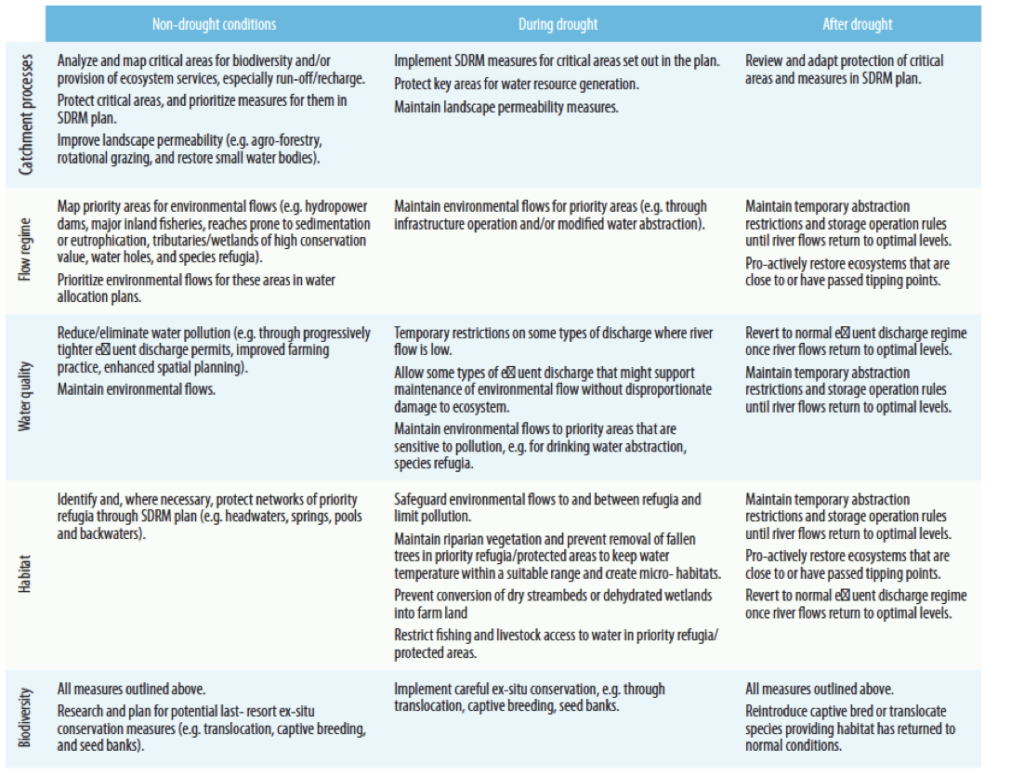
Enabling environment of Strategic Drought Risk Management
To successfully implement SDRM, greater coordination and cooperation between those with an interest in water-related issues is required to develop and implement more innovative strategies. Drought managers must:
* establish and maintain political momentum
* engage a broad range of stakeholders
* support other water and development policies and regulations, as appropriate
* be honest about the evidence on drought hazards and risks.
How SDRM supports the transition to a drought-resilient society
A drought-resilient society evolves to develop a new relationship with water that recognises the mutual dependence between human development and freshwater ecosystems. This goal requires more than simply ‘preparing for’ and ‘responding to’ drought; it considers drought risk alongside broader water resource and development issues.
In practice, transitioning to a drought-resilient society requires political acceptance of drought risks, widespread awareness of those risks and momentum to act. The nature of this transition is summarised in Figure G.
Figure G. Making the transition from a drought-sensitive society to a drought-resilient society is the role of Strategic Drought Risk Management
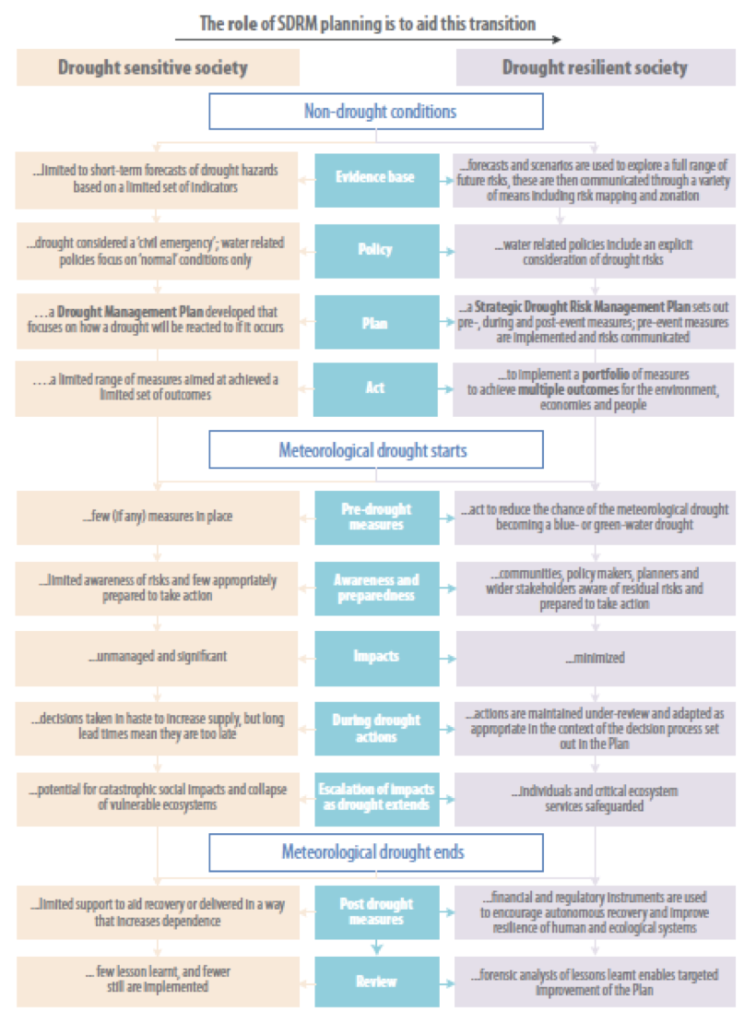
1.1. Eight Golden Rules to support Strategic Drought Risk Management
Underpinning a strategic framework of risk analysis and management is recognising the drought risk system as a construct of climatic, hydrological, socio-economic and ecological systems.
This approach is well developed for many other natural hazards (for example, Sayers et al., 2013 and 2014a) but is yet to emerge for drought. However, it is possible to identify a small number of principles that are prerequisites for the successful delivery of SDRM. These ‘golden rules’ are summarised in Figure H.
- Set multiple goals and objectives that promote positive long-term outcomes for society: SDRM is more than securing emergency drinking water supplies. It is about reducing drought impacts across society – including households, agriculture and industry – and safeguarding biodiversity and ecosystem services. SDRM delivers long-term outcomes and avoids short-term solutions that may have negative impacts. The success of SDRM is measured against multiple objectives achieved over different timescales.
- Encourage stakeholders from a variety of different sectors and realms to participate: Good decisions rely on governments, businesses and communities being active participants. SDRM fosters a framework of collaboration that supports political momentum for change and sharing responsibility and fiscal support for implementing measures.
- Implement a portfolio of measures to prepare for, respond to, and recover from drought and transform society’s resilience to drought: Integrated management of drought risk involves considering the widest possible set of management actions, including measures to reduce the probability of blue-water droughts, incentivising to adapt to drought risks and enhancing reserve capacity through appropriate green or grey infrastructure.
- Utilise limited resources efficiently and fairly to reduce risk and maximise opportunities: The level of effort to manage drought risk must be context specific and not based on universal or generalised standards of supply reliability. SDRM considers the efficiency of management measures for risk reduction, resources, fairness and ability to maximise ecosystem opportunities.
- Assess whole system behaviour and associated risks and uncertainties over the short- and long-term: The drought risk system is more than meteorology and hydrology. It consists of climatic sources, hydrological pathways and receptors that may be harmed (i.e. people, ecosystems and economies). An appropriate understanding of this whole system, and how it might respond to external influences and management responses over the long-term is a prerequisite to making good choices. However, uncertainty within the data and models must be acknowledged and the choices made must be robust despite that uncertainty.
- Communicate risks (and associated uncertainty) effectively and widely: Decision makers and the public must understand drought risks. Risk and the associated uncertainty must be communicated effectively to enable both communities and individuals to prepare and support risk reduction measures. Initiating communication during a drought is too late.
- Understand inherent controversies and trade-offs: Managing trade-offs that will inevitably arise requires extensive discussion and the preferred approach may require significant changes in practice that challenge the status quo. Efforts to understand these trade-offs and how they will be managed are a core component of any SDRM plan. Decisions made in haste during a drought seldom balance competing needs adequately and often produce ineffective, inefficient or inequitable results.
- Embed a continuous process of review and adaptation: The world is changing. Climate change, demographic change, changes in the hydrological response of the basin and other societal changes mean that planning processes that maintain the status quo are no longer adequate. Strategic drought risk management is a continuous process of review and adaptation and is a pre-requisite for delivering desired outcomes.
Figure H. Golden rules of Strategic Drought Risk Management

1.2. Drought hazards
THE NATURE OF THE DROUGHT HAZARD
Droughts are said to be a ‘creeping hazard’ (Gillette, 1950). A drought can persist for many years, extend across large areas and have multiple impacts on economies, ecosystems and societies.
Droughts are typically associated with large-scale impacts, often driven by regional or even global-scale climate features. As a result, droughts can be widespread, influencing multiple basins simultaneously (Figure 1.1).
Drought is also persistent. An extended single event or a series of successive ‘dry spells’ may mean water resources, ecosystems and economies are not able to fully recover before the next drought occurs. For example, the 1930s ‘Dust Bowl’ drought in the US, although viewed as a single drought episode in terms of its devastating impacts, was driven by several distinct ‘dry’ periods, each of which was an individual meteorological drought episode, embedded within a larger-scale drought pattern. Each period of dryness occurred in such rapid succession that affected regions were unable to recover adequately before the next drought began. The Millennium Drought in Australia is also often considered a single event, but it is the result of multiple meteorological drought events.
In other natural hazards such as hurricanes, floods and earthquakes, simple observations provide a means of determining the onset and end of the event. The severity of a drought, however, develops subtly over time. As a result, the onset of drought can often only be defined in hindsight.
This is perhaps a unique characteristic of drought and is part responsible for the ambiguity of what constitutes drought and how drought intersects with water policy more generally.
TRADITIONAL DEFINITION OF DROUGHT
Drought is ultimately about a lack of water. Throughout history there has been little disagreement about the general meaning of drought. Beyond this general understanding, the definition of drought becomes more diffuse. Palmer (1965) wrote: Drought means various things to various people depending on their specific interest.
To the farmer drought means a shortage of moisture in the root zone of his crops. To the hydrologist, it suggests below average water levels in the streams, lakes, reservoirs, and the like. To the economist, it means a shortage which affects the established economy.
Throughout the 1950s, 1960s and 1970s definitions of drought were primarily associated with the hydrological cycle, ‘a deviation from the normal hydrological conditions’ (Palmer, 1965).
Definitions subsequently evolved to reflect the importance of meteorological persistence (‘an extended deficiency in precipitation’ (WMO, 1986)), and severity (‘precipitation significantly below normal recorded levels’ (United Nations, 1994)).
In the latter half of the 1990s, definitions also started to include ‘impacts’. At first, agricultural impacts were the key concern (‘adversely affect land resource production systems’ (United Nations, 1994)) before a broader socio-economic perspective was adopted (‘insufficient to meet the demands of human activities and the environment’ (Wilhite and Buchanan- Smith, 2005)). The recognition that droughts are a feature of all climates and can and should be planned for was also introduced more directly from the mid-2000s (‘a normal, recurrent feature of climate, although often erroneously considered an unexpected and extraordinary event’ (MWD, 2007)).
As a result, a multitude of definitions of drought has evolved that reflect changes in perception and context of time (Table 1.1, based on a review by Belal et al., 2012).
Figure 1.1. Droughts are widespread as highlighted by the drought events in Europe over the past decade

Table 1.1. Drought and its definitions
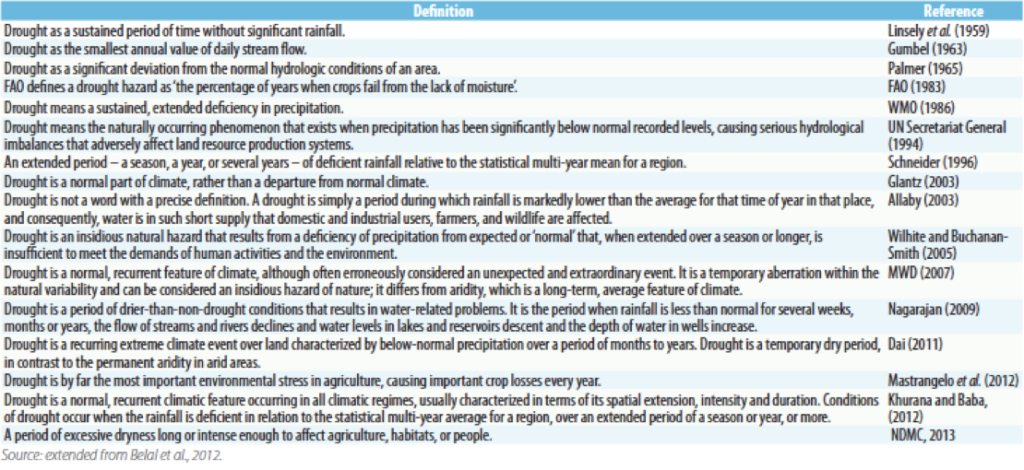
A MODERN CLASSIFICATION OF DROUGHT
The traditional classification of drought types has primarily evolved from the meteorological and hydrological sciences and more recently the classification has extended to reflect agricultural and socio-economic impacts.
Today, a myriad of drought types exist with few accepted definitions; this lack of clarity has hindered progress in managing drought.
A more proactive, whole-of-system management of drought risk requires traditional drought types to be challenged and alternative definitions proposed that distinguish different aspects of the hazard.
A new classification is proposed here that highlights this distinction and avoids the arbitrary sub-division of the hydrological cycle imposed by traditional drought types. This new classification is highlights how drought impacts have the potential to cascade and escalate through the freshwater ecosystems and human systems (Figure1.2).
A meteorological drought may, for example, result in reduced infiltration to groundwater and reduced stream flow.
A blue-water drought may restrict habitat connectivity and reduce water quality with consequences for riparian ecosystems, groundwater-dependent ecosystems, and in-stream ecological processes such as fish spawning. Fish abundance may decrease as the ability of a river to dilute pollution load decreases.
Loss of reservoir storage and access to cooling waters is likely to impact energy production. These impacts, together with restrictions on water use, can slow economies and livelihoods can be lost. Crops will fail with a reduction in soil moisture in a green-water drought and soil cover will be lost and the threat of wildfires will increase.
In a prolonged drought, the combined effects can lead to ecosystem collapse, famine and severe societal conflict. Although this escalation of impacts will be different in each basin, and the important ecosystem services impacted will vary by sector, an interaction between human systems and freshwater ecosystems will always exist.
Meteorological drought
Precipitation deficiency (often coupled with increased heat stress but not always) is the fundamental driver of a drought and is traditionally referred to as a meteorological drought. Although defined similarly in many documents (e.g. Belal et al., 2012; Mishra and Singh, 2010; Quiring, 2009) no single definition prevails.
A meteorological drought is defined as:
A temporary, negative and severe deviation from the average precipitation values that persists for a sufficient period of time to significantly reduce blue-water or green-water resources in a river basin or region.
Blue-water drought
Absence of, or reduction in, available water stored in freshwater lakes, rivers, aquifers and wetlands (WWAP, 2009) is referred to here as a blue-water drought, often traditionally referred to as a hydrological drought (e.g. Belal et al., 2012; Mishra and Singh, 2010; Quiring, 2009).
A meteorological drought may or may not lead to a blue-water drought – it depends on the nature of the meteorological drought and the hydrological response of the basin. The intensity, duration and spatial extent of the meteorological drought is important.
For example, if the meteorological drought is relatively short and, at the onset of the meteorological drought, groundwater aquifers and reservoirs are full, a blue-water drought may not occur.
The temperature and season of the meteorological drought are also important. For example, a blue-water drought also depends on the demand for consumptive water use, particularly from the agricultural sector, and evapotranspiration.
Other factors, such as domestic and industrial consumption or dam infrastructure will also affect the hydrological characteristics of the basin and the relationship between meteorological droughts and blue-water droughts. In larger basins, it is also possible that a meteorological drought in a specific location and time (e.g. upstream and in winter) will have a more significant impact than the same meteorological drought occurring elsewhere within the basin or at a different time (for example, the absence of snow fall upstream may limit the spring snow melt and future downstream flows).
Bluewater droughts can have major impacts on irrigated agriculture, industry, energy production and domestic water availability, and reduced aquatic food production.
A blue-water drought is defined as:
An unusual and significant deficiency in the water stored in freshwater lakes, rivers, aquifers and wetlands.
Green-water drought
A green-water drought refers to the absence of, or reduction in, available water stored in or on top of the soil or vegetation (WWAP, 2009). Green-water is vital for crop and plant growth.
A reduction or absence of green-water is traditionally referred to as an agricultural drought (e.g. Belal et al., 2012; Mishra and Singh, 2010; Quiring, 2009) and typically defined as a deficiency of moisture in the soil layer from which crops normally draw their water.
This definition is narrow and implies impacts are limited to agriculture, whereas direct effects may also be felt across other land uses (e.g. forestry) and freshwater ecosystems and reduction or degradation of aquatic and terrestrial habitat.
Indirectly, green-water drought can impact on the availability and pricing of agricultural produce.
The impact of a green-water drought on agricultural production, other land uses and freshwater ecosystems depends on the timing of the drought.
For example, deficient soil moisture when a crop is planted may stop germination, leading to low
plant populations. During other times, crops may be better able to cope with reduced access to water.
A ‘socio-economic drought’ has traditionally been used to describe a drought hazard that is sufficiently severe to cause socio-economic impacts. This definition has no place in the context of the risk approach used in this book because the impact of a drought is considered explicitly in the estimate of drought risk that is, by definition, concerned with hazard and impact.
A green-water drought is defined as:
An unusual and significant deficiency in the water stored in the soil layer (from which plants and crops normally draw their water) and/or in vegetation itself.
Figure 1.2. Defining water security, scarcity, drought and related concepts

DEFINING WATER SECURITY, SCARCITY, DROUGHT AND RELATED CONCEPTS
Water security, drought (as a hazard), water scarcity and other related terms are often muddled.
Table 1.2 sets out the conceptual distinction between (i) the philosophy of water security, (ii) the climate- driven issues of dry spells, droughts, aridity and associated desertification and (iii) the
human-induced issues of water shortages, stress and scarcity.
Extending these qualitative distinctions to standard quantified definitions is more problematic because they are likely to be context specific. However, the conceptual relationships set out in Table 1.2 remain valid across contexts.
Table 1.2. Defining water security, scarcity, drought and related concepts (adapted from Schmidt, 2012)
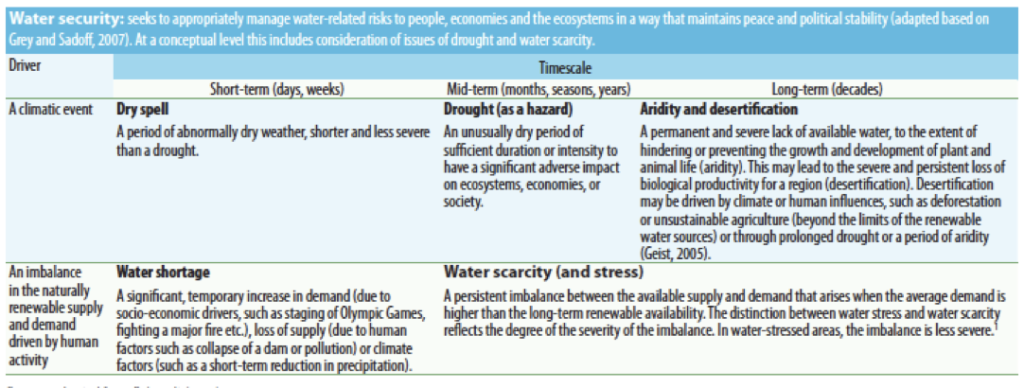
1.3. Climate drivers of drought
LARGE-SCALE CLIMATE FEATURES
Drought is a climate response. Droughts do not develop during a single weather event, but develop over a period of time.
Large-scale features that carry continental, rather than oceanic, air masses and ridges of high pressure can block or restrict the development of thunderstorm activity or rainfall over a certain region. These features often cause prolonged periods of dryness, typically associated with unusual heat and wind that exacerbate the drying effect (Box 1).
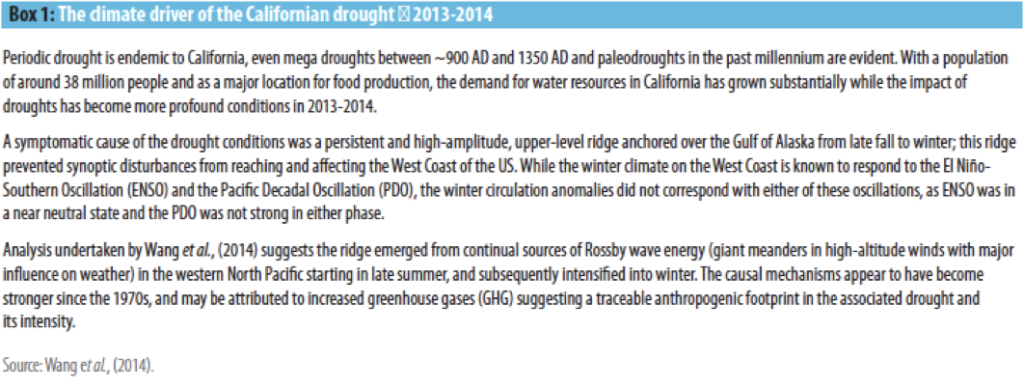
El Niño Southern Oscillation
ENSO refers to a sequence of changes that are induced when warming is particularly strong across the Pacific Ocean and the Indonesian archipelago, on average every three to eight years.
Two variations of the ENSO exist (i) the warm oceanic phase (known as El Niño, ‘the boy-child’2) that accompanies high air surface pressure in the western Pacific, and (ii) the cold phase (known as La Niña, ‘the girl-child’) that accompanies low air surface pressure in the western Pacific. Such events drive wetter than normal weather in some regions and drier than normal weather in others.
For example, El Niño episodes are usually accompanied by sustained warming of the central and eastern tropical Pacific Ocean and a decrease in the strength of the Pacific Trade Winds. This can cause, for example, a reduction in winter and spring rainfall over much of eastern and northern
Australia (Power et al., 1999) and droughts conditions in India (Kumar et al., 2006). During La Niña episodes, the Pacific Trade Winds strengthen resulting in warmer seas to the north of Australia, while waters in the central and eastern tropical Pacific Ocean become cooler. Together, this effect gives an increased probability that eastern and northern Australia will be wetter than normal and droughts will be less likely.
Pacific Decadal Oscillation and Interdecadal Oscillation
The PDO and the Interdecadal Oscillation are patterns of change in the Pacific Ocean’s climate. During a ‘warm’ phase, the eastern ocean warms and the west Pacific becomes cool; during a ‘cool’ phase, the opposite pattern occurs. The oscillation shifts phases on at least an inter-decadal timescale, usually about 20 to 30 years. The spatial patterns and impacts are similar to those associated with ENSO events and, during the ‘warm’ phase, warm, humid air is advected along the North American west coast and temperatures are higher than usual from the Pacific Northwest to Alaska, but below normal in Mexico and the south-eastern US. The PDO is also considered to strongly influence the multidecadal droughts pattern in the United States, with drought frequency increased over much of the northern US during the warm phase and over the south-west US during the cold phase (McCabe et al., 2004).
Atlantic Multidecadal Oscillation
The Atlantic Multidecadal Oscillation (AMO) has an influence on sea surface temperature in the Atlantic Ocean and is correlated to air temperatures and rainfall over much of the Northern Hemisphere, in particular, North America and Europe. Major droughts in the US midwest and the southwest have been correlated with the AMO’s warm phase with two of the most severe droughts of the 20th century occurring during the positive AMO between 1925 and 1965: The Dust Bowl of the1930s and the 1950s drought. Elsewhere, the warm phase of the AMO can increase summer rainfall (for example over India and Sahel), a pattern reversed during its cold phase (ShuangLin et al., 2009).
Figure 1.3. Typical rainfall impacts from El Niño (top) and La Niña (bottom)


LOCAL HYDRO-METEOROLOGICAL PROCESSES
At a local scale, various hydro-metrological processes are important for determining the level of water vapour in the atmosphere and whether or not precipitation forms.
These processes include temperature, radiation, wind stress, relative humidity, and pressure. In some regions, the seasonal timing of lack of precipitation can be crucial. For example, a lack of snowfall during the winter can have a significant impact on water availability the following spring and summer in catchments that rely of snowmelt. In England, for example, groundwater levels are crucially dependent on winter rainfall and are less affected by changes in summer rainfall (Marsh et al., 2007).
1.4. Drought impacts
Droughts are pervasive; individuals, companies, habitats and species are all affected. The most severe droughts can be devastating.
The 1942 drought in Bengal, India was the underlying cause of a widespread famine the killed 1.5 million people.
The 1976–77 drought in the US has been estimated to have lost the US economy US$1.775 billion (California Department of Water Resource, 1978).
Widespread ecosystem impacts have also been observed, evidenced by the increase in tree mortality across Canada’s boreal forests after a series of regional droughts from 1963–2008, (Peng et al., 2011).
Even less severe droughts have an impact on agricultural productivity, urban water supplies and ecosystems. Drought also plays a role in shaping ecosystems. Many ecosystems are well adapted
to some degree of drought, and some species have evolved mechanisms to take advantage of drought conditions.
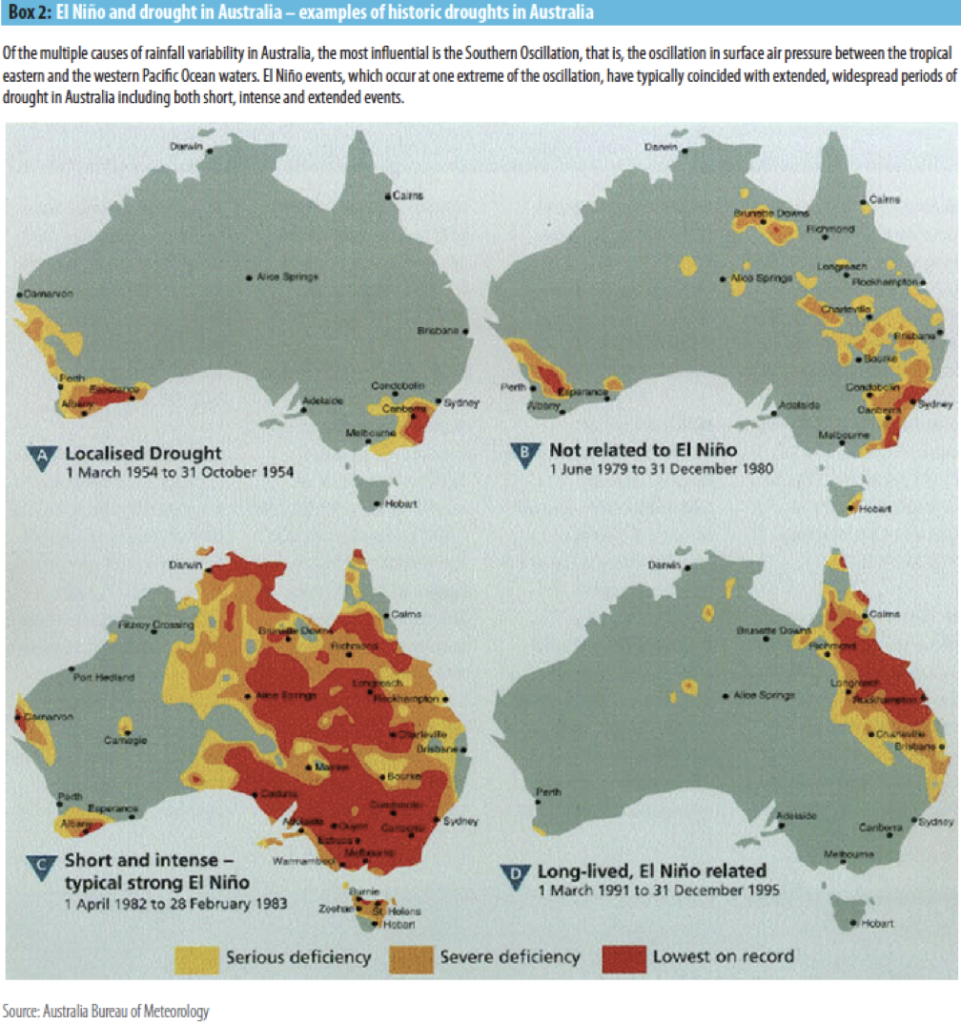
IMPACTS ON FRESHWATER ECOSYSTEMS
Freshwater ecosystems are defined here as river channels and the water within them, the floodplains, lakes, aquifers and upstream catchments including, for example, watershed forests that influence run-off as well as the plants and animals that live in and around those systems and agro-ecosystems that depend significantly on freshwater habitats.
Freshwater ecosystems provide benefits to people and society, including natural resources to support human development; ecological functions such as nutrient cycling and carbon sequestration that sustain the planet; and intrinsic values such as wildlife and scenic areas that people can appreciate and enjoy. The term ‘ecosystem services’ is often used to describe these benefits and is commonly considered in four categories (MEA, 2005):
- Provisioning services provide food, fibre, medicines, and freshwater flows for key economic activities such as power generation and agriculture, as well as services on which individual lives and livelihoods may depend, such as river and lake water for domestic use and subsistence farming, fish stocks, and water flows for tourist activities such as rafting.
- Regulating services provide filtration of pollutants by wetlands, climate regulation through carbon storage and water cycling, pollination, and protection from disasters such as drought by regulating groundwater recharge, water storage and releases.
- Habitat and supporting services provide functions for the production of other ecosystem services such as soil formation, photosynthesis, pollination and nutrient cycling.
- Cultural and amenity services provide benefits through interaction with the natural environment such as education, recreation, spiritual values and aesthetic values.
Drought threatens all four categories of ecosystem services (Table 1.3). The Global Assessment Report (ISDR, 2011), for example, highlights that between 1999 and 2005 droughts contributed to the loss of at least 100,000 hectares of salt marshes along Florida’s coastline in the US and in Spain the 1991–1995 drought indirectly resulted in draining wetlands, causing saltwater intrusion of coastal aquifers.
Droughts also play a positive role in ecosystems with minimal anthropogenic disturbance or that experience regular dry seasons. For example, low-flow periods are believed to be a major force in maintaining biodiversity (Everard, 1996): they enable some species such as certain floodplain plants to be successfully recruited (Humphries, King, and Koehn, 1999); purge invasive species that are less well adapted the local setting (Lake, 2003) (MEA, 2005); and can also benefit predators by concentrating prey into limited areas. Drought also impacts terrestrial ecosystems and there is an interaction between terrestrial and freshwater ecosystems, especially during green-water droughts that increase the chances of wildfires, dieback of forests and grasslands, impacts on terrestrial animals that, for example, die off from thirst or starvation.
Direct and indirect impacts on freshwater biota
Droughts can cause progressive loss of freshwater habitat, decline in water quality and depletion of food resources, which may result in a number of biotic responses including changes in population densities, species richness, life-history schedules, species composition, patterns of abundance, type and strength of biotic interactions, food resources and trophic structure (Lake, 2003). The impacts of a drought on freshwater biota can also persist for some time after the end of a meteorological drought. For example, the 1976–77 drought in California eliminated a population of the caddisfly (Resh, 1992), taking 10 years for the original population structure to be restored (Lake, 2003). Droughts have both direct and indirect impacts on freshwater biota:
- direct impacts are those caused by loss of water and connectivity, as well as habitat reduction and reconfiguration;
- indirect impacts are those caused by the changes in water quality, biotic interactions (especially predation and competition), and other ecosystem elements or processes as a result of loss of water and connectivity.
Table 1.3. Impacts of drought on freshwater ecosystem services
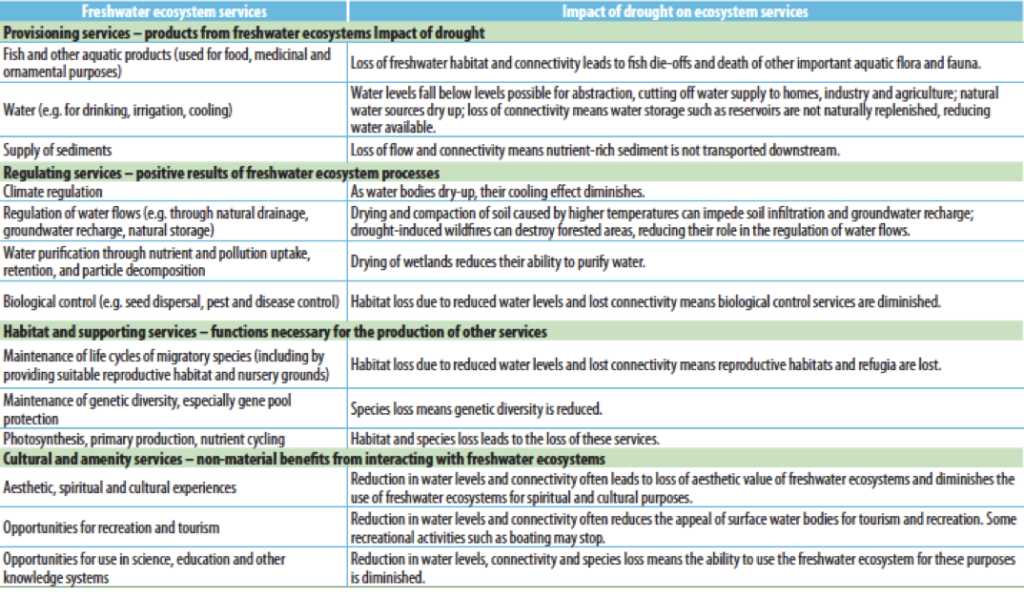
Table 1.4. Drought impacts on human systems are exacerbated when freshwater ecosystem services are impacted by drought

Impact on the stability of freshwater ecosystems of prolonged drought
Prolonged drought can lead to tipping points or thresholds that, if crossed, result in abrupt, non-linear shifts in freshwater ecosystem states. For example, ecological changes may be gradual while a riffle dries, but cessation of flow causes abrupt loss of a specific habitat, alters physicochemical conditions in pools downstream, and fragments the river ecosystem.
Crossing such geomorphological or hydrological thresholds causes abrupt changes in biological community structure and ecological processes, resulting in a stepped response – between a gradual change while a threshold is approached followed by a swift transition when a habitat disappears or is fragmented (Humphries and Baldwin, 2003).
When certain critical thresholds are crossed, impacts on freshwater biota may be disproportionately severe (Boulton, 2003), which may hamper the recovery of a species.
Such dramatic changes in freshwater ecosystems rarely occur because of drought alone, but typically result from a combination of gradual alterations in drivers of environmental change, external shocks (such as a drought, flood, fire or disease outbreak), and anthropogenic degradation.
IMPACTS ON HUMAN SYSTEMS
Almost all human activities rely on water. Human systems include strategic priorities for, and demands on, the freshwater system and the services it provides. Droughts can therefore have a significant impact on human systems. Some of the most important impacts are summarised in Table 1.4.
The public health concerns raised in connection with the California drought by the Center for Disease Control and Prevention (CDC) are summarised in Box 3.
HUMAN AGGRAVATION OF DROUGHT IMPACTS
A range of pressures can aggravate the severity of the impacts on the freshwater ecosystem or slow (or even prevent) its recovery (Figure 1.4). The root causes of this is often poor planning, including:

Figure 1.4. The impact of a drought on a freshwater ecosystem may be aggravated by poorly planned human development and water resource management

Poorly planned and regulated human development.
Many development activities if poorly planned or poorly implemented can aggravate drought impacts. For example:
(i) Extractive activities such as water abstraction for irrigation, livestock, industry and domestic purposes reduces river flows, increasing the vulnerability of freshwater ecosystems to drought.
During drought, increased demand for water may lead to higher levels of water abstraction, exacerbating impacts, particularly in sensitive habitats;
(ii) Pollution including chemicals, heavy metals, and nutrients all have an impact. Agricultural activities, for example, reduce riparian vegetation and increase the input of nutrients and sediments into surface waters, causing marked declines in habitat and water quality;
(iii) Land use and land cover change can lead to habitat fragmentation due to urbanisation or infrastructure development, reduced infiltration and groundwater recharge and base flows to rivers as well as encouraging lower biodiversity farming practice that increase vulnerability to drought;
(iv) Biological disruptions such as the introduction of non-native invasive species, disease, and pests may increase stress on habitats and species and reduce their ability to cope with drought.
Poorly management of water resources and inappropriate measures to combat drought. Examples include:
(i) Failure to provide environmental flows leading to reduced pulse and base releases from reservoirs;
(ii) A driver for intensification leading to more vulnerable or inappropriate agricultural practices;
(iii) Regional impacts due to inappropriate exploitation of resources outside of the basin through inter-basin transfers; and
(iv) Unsustainable use of groundwater resources.
When both development and water resources are poorly planned a range of impacts can threaten ecosystem structure and function. These include for example the rapid die-off of biota, saline intrusion and contamination of groundwater sources and even loss of soil cover.
Underlying these processes is the role of human influence on climate. Despite considerable uncertainty about how climate change will influence droughts, it is generally accepted that the severity of future droughts will increase (Pachauri, 2008). For example, globally, the proportion of land surface in extreme drought is likely to increase; some estimates suggest this could be by a factor of 10 to 30 by the 2090s (Burke et al., 2006).
At a more regional scale, developing an understanding of the potential impacts of climate change requires a detailed understanding of the hydrological resources of the basin. For instance, as temperatures have warmed over the past century, the prevalence and duration of drought has increased in western North America (Konstantinos and Leetenmaier, 2006).
This impact reflects a number of climate change factors. For example, there is high confidence that increased temperatures lead to more precipitation falling as rain rather than snow, earlier snow melt, and increased evaporation and transpiration.
Much of the mountainous western states of the US have experienced a decline in spring snowpack, especially since the 1950s (Mote, 2006). Earlier snowmelt, associated with warmer temperatures, can lead to water supply being increasingly out of phase with water demands. While there is some variability in the models for western North America as a whole, climate models unanimously project increased drought in the southwest. The southwest is considered one of the more sensitive regions in the world for increased risk of drought caused by climate change (Sheffield and Wood, 2008). Drought management therefore has a legitimate interest in the mitigation of climate change as well as adapting to it.
Summary
This section has explored what is meant by ‘drought’, the climate drivers of drought, including large-scale climatic features such as La Niña and El Niño, and the range of impacts a drought can have on human systems and freshwater ecosystems.
The discussion reaffirms that drought is an extreme event and presents a new classification of ‘drought hazard’ based on meteorological, blue-water and green-water considerations.
The new definition does not conflate hazard and risk as traditional definitions often imply; it distinguishes drought from issues of water scarcity while highlighting the interactions between the
two.
The impact drought has on human systems and freshwater ecosystems, which sometimes leads to profound impacts such as famine and ecosystem and societal collapse, are also explored.
2.1. Introduction
Droughts are an ever-present threat in almost all countries. The majority of droughts have been responded to ‘as they happen’ with authorities and communities often struggling to deliver emergency relief. In response, drought planning and management has largely developed on an ad hoc basis, reflecting lessons learnt from particular drought episodes and the capacity of communities to react to those lessons. As lessons are learnt, drought management practice and policy evolves. Often, when rain returns, the impacts of drought are soon forgotten and society loses the momentum to better prepare for the next drought episode (Figure 2.1).
Figure 2.1. The hydro-illogical cycle: Drought risks are all too often forgotten and societies persistently fail to prepare
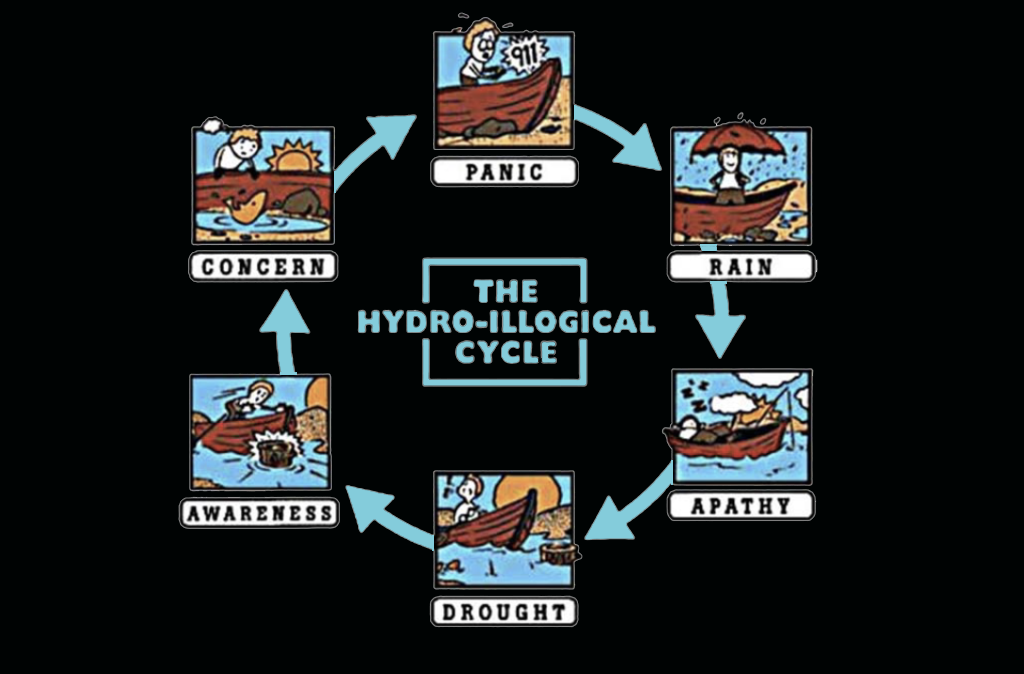
This does not mean that drought events have had no influence on policy or practice. Society’s approach to drought management has undergone significant change throughout history in response to the lessons learnt from past events and as a result of advances in science (Figure 2.2).
This evolution (from nomadic–disaster–emergency–strategic) also links closely to humans’ evolving relationship with ecosystems during droughts from learning to live with the changing ecosystem as the drought unfolds, to exploiting ecosystems, to recognising interlinkages between societal well-being and ecosystem health, and the role that ecosystems can play in reducing drought risk.
This section concentrates on both the lessons from past droughts and parallel advances in science and philosophy that shape this evolutionary path as well as the live issues and challenges that are still to be overcome.
Figure 2.2. The evolution of drought risk management
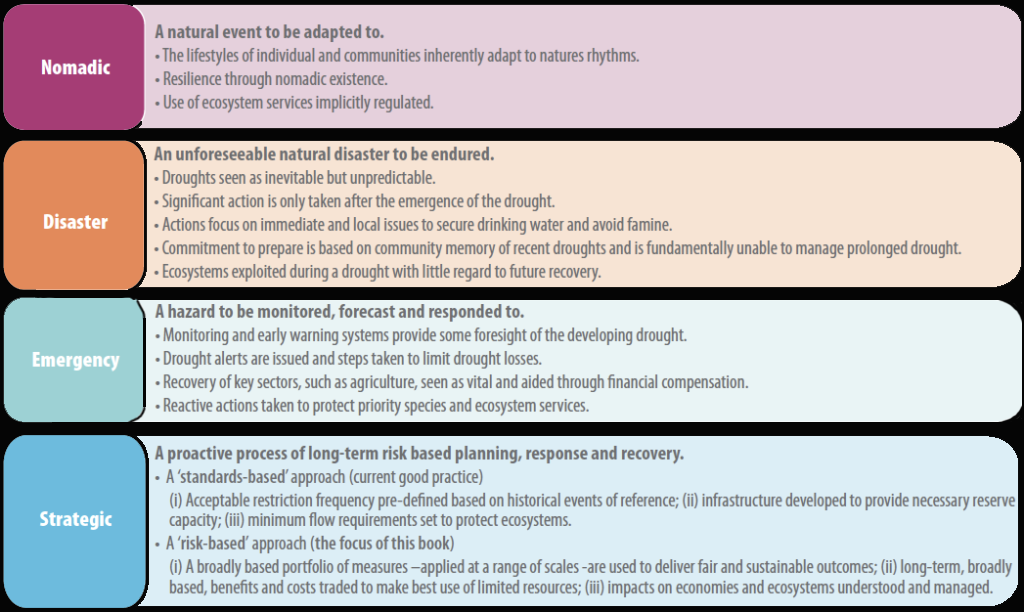
2.2. Historical droughts:
lessons learnt
DROUGHTS IN ANCIENT TIMES:
4000 BC TO 500 AD
The decline of Bronze Age civilisations in Egypt, Greece and Mesopotamia has frequently been attributed to a succession of drought events and associated famines between 3000 BC and 1000 BC (Bernhardt et al., 2012; Weiss, 1982).
Recent studies suggest drought may have played a similar role in the demise of the Harappan Civilisation within the Indus Valley (Marris, 2014; Dixit et al., 2014). Analysis of Oxygen-16 and
Oxygen-18 isotopes taken from the sediment of an ancient lake suggest that the monsoon cycle, vital to the livelihood of all of South Asia, stalled for as long as two centuries.
From around 1800 BC, the Harappan Civilisation slowly lost urban cohesion, and their well-planned cities with advanced municipal sanitation systems were gradually abandoned.
Dendrochronology studies have highlighted evidence for a persistent period of European drought from around 124 AD to 210 AD (Bungten et al., 2011). This is likely to have weakened the Roman Empire economically, depopulating marginal agricultural areas and reducing farm production in general.
Throughout this period, China also experienced a number of large-scale droughts, resulting in significant loss of life (Table 2.1). These extreme droughts had deadly consequences. Crops failed, millions of people died from the resulting famines, economies collapsed and civil unrest often followed.
The earliest communities implicitly accepted these risks as part of life. They adapted to nature’s rhythms through a nomadic existence, always moving to find food and water. Resilience was achieved through flexibility. As communities became more settled, they had little ability to protect themselves from the worst effects of drought. Although droughts were seen as inevitable, early civilisations did attempt to prepare for them.
With a focus on saving lives and avoiding famine, many of the reactive approaches used would be familiar to us today:
- Use of historical reference droughts. Often, preparing for drought reflected the collective memory of past drought events.
- Food stockpiling. Food stockpiling has always been a core strategy to mitigate the worst impacts of drought and prevent famine. There is evidence in the Old Testament (Genesis, Chapter 41) that food stockpiles date back more than 4,000 years, it provides details of how the Egyptians stockpiled enough food for two years.
- Water restrictions. Prioritising the use of water has also always been a natural response to periods of drought. The start of the evolution of urban water management can be seen in Ancient Greece when the early Minoan civilisations attempted to balance supply and demand (Koutsoyiannis et al., 2008). It is unclear if water restrictions were implemented as a management option during periods of drought, but it is likely that they were.
- Developing inter-regional transfers. There is evidence that early civilisations used water transfers from one basin to another as part of water management and drought planning. For example, the Hangou waterway was operating in ancient China in 486 BC (Liu and Zheng, 2002). The Romans built extensive networks of aqueducts, the first of which was built in Rome in 200 AD (Fantham, 2010). The Ancient Greeks constructed large-scale hydraulic projects for water transport during the oligarchic periods (Angelakis and Koutsoyiannis, 2003). Although on a significantly smaller scale than some of the mega-transfers developed in recent years, such are the south–north transfer scheme in China, these smaller-scale, inter-regional transfers often made an important contribution to overall resources.
Table 2.1. Selected droughts in China: 0 AD to 500 AD: impact on society
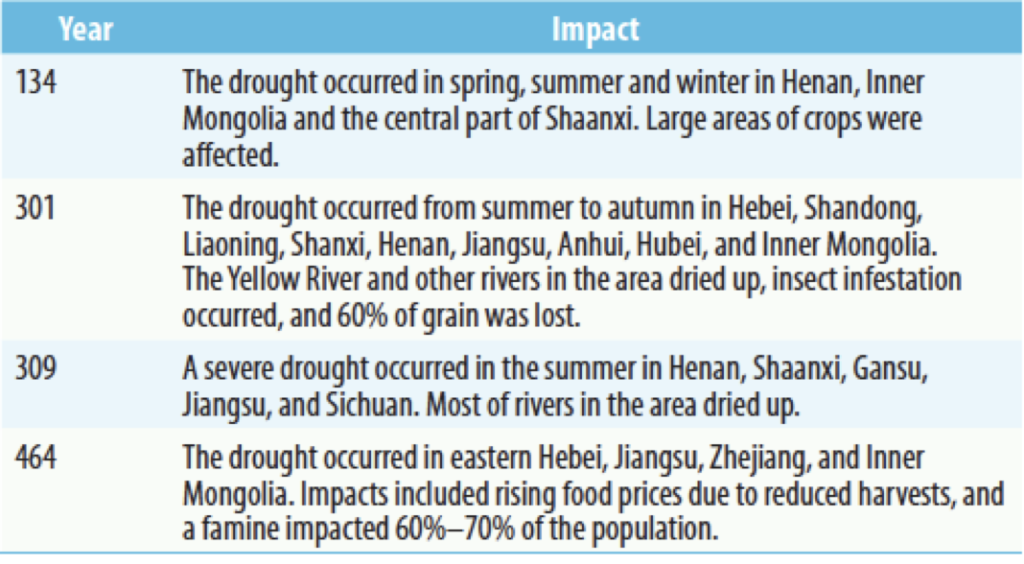
DROUGHTS IN THE MIDDLE AGES:
500 AD TO 1500 AD
In England and across Europe, environmental shocks were instrumental in restructuring of the economy and society (Gerrard and Petley 2013), including the Great Famine (1315– 22) and the Black Death (1348–9). In China, a severe drought (1637-1646) during the reign of Emperor Chongzhen of the Ming Dynasty affected more than half of the population. Agricultural production collapsed and prices rose, eventually leading to revolution and the collapse of the Ming Dynasty in 1646 (GIWP, 2013).
In many ways Medieval Society however was a risk-based society with an increasingly sophisticated toolkit in hazard mitigation, adaption and development of measures of protection.
The measures taken to manage the flooding in the Netherlands and China are well documented (e.g. Sayers et al., 2013). Although less well recorded, it is clear that non-structural and structural
responses were all features applied to the management of drought too, for example:
- Non-structural measures. Cooperative and collective action was a particular feature of medieval life. Economic losses were often shared across the community. For example, after the 1333 flood in Florence, city authorities formed a committee to oversee the repairs, lowered taxes on imported foodstuffs, organised tax relief for those in need, and helped the distribution of food supplies. Attempts were also made to spread the burden of loss over longer periods to reduce the immediate severity of an event. Across medieval Europe, monastic estates provided centralised storage for un-threshed grain, while supplies of threshed grain were piled in cellars and upper storeys as well as in civic granaries (Gerrard and Petley, 2013). Margins were tight and quantities insufficient to ride out a long crisis (Claridge and Langdon, 2011), but localised shortfalls could be overcome temporarily by releasing a portion of what was held in store. An alternative, if costly, strategy was to purchase grain from outside the local area. For example, in the winter of 1316, English merchants bought up stores of corn, and even went abroad to buy more (Kershaw, 1973). This option was preferred when impacts were geographically widespread and demand could not be met locally. Following the eruption of Mount Rinjani in Indonesia (1258–1261), a combination of dust and drought plunged England into famine as crops failed. Grain was then shipped from Germany and Holland into London (Stothers, 2000). To avoid profiteering, permanent community stockpiles of grain that could be used on demand also started to emerge, such as the Leadenhall Granary, built in the 1440s in London (Samuel, 1989).
- Structural measures. Infrastructure responses to water resource issues such as storage reservoirs and water transfer schemes feature as societies developed. Specific consideration of drought risks is more difficult to discern but are likely to have been considered.
- Adaptation. Cooperation and sharing was also common in Medieval times. For example, in parts of Medieval Spain villages were dependent on a network of hydraulic or gravity-flow canals that required cooperation between upstream and downstream irrigators to operate successfully.
- Resilience. The degree of preparedness and resilience of societies was a function of collective experience of the hazard. Greater resilience was found in communities frequently exposed to natural hazards, for example in regions prone to frequent flooding and among so-called ‘seismic cultures’ that learnt to live with frequent earthquakes (Gerrard and Petley, 2013). As a consequence, low-frequency, high-magnitude events (such as droughts) generated higher losses, at least in part because preparedness was lower.
DROUGHTS AND INDUSTRIALISATION:
1700s TO 1930s
During the period 1700s to 1930s, droughts were perceived as a disaster to be endured. With limited capability to forecast drought and little capacity to prepare, in most cases droughts were responded to as they occurred. Efforts were concentrated on limiting the worst of the impacts. Other than investment in storage infrastructure, there was little evolution of drought policy or practice throughout this period. Although some droughts would have yielded important lessons, few seem to have been acted upon.
Instead the focus was on satisfying the growing industrial demand as many societies transitioned from cottage based industries to machine-based economy and from a subsidence agricultural sector to a rapidly growing urbanised and industrialised society. As a result, significant investment was directed towards securing water resources. Despite the additional supply that resulted, the margin between supply and demand tended to worsen increasing vulnerability to drought; a vulnerability exposed by a number of major droughts (Table 2.2).
Table 2.2. Selected droughts: 1700 to 1930: impact on society and influence on drought management policy and practice

DROUGHTS FROM THE GREAT DEPRESSION TO THE LATE 20TH CENTURY:
1930s TO 1970s
From the Great Depression to the late 20th Century, governments and international aid agencies acted in response to a drought. This emergency management approach focused on acute (i.e. severe and brief ) impacts to humans, with little attention given to impacts on ecosystems and their services, and the longer-term knock-on impacts for society. Little attention was given to preparedness, mitigation, and prediction or early warning actions that could reduce future impacts. As in previous centuries, the focus on emergency management meant countries often experienced severe impacts when drought occurred (Table 2.3). Almost without exception, the reactive nature of the emergency management approach was exposed as ineffective and drought relief measures were often poorly targeted and did little to reduce vulnerability to the next drought. In fact, drought relief efforts often increased vulnerability to future events by reducing the level of self-reliance and increasing dependence on external assistance such as penalising efforts to prepare for future droughts by rewarding those that who failed to prepare with financial compensation.
The conflicts in Sudan and Chad that continue today are, in part, a response to decades of poorly managed droughts that continue to force pastoralist communities (and their livestock) south in search of water and onto land mainly occupied by settled farming peoples (Xavier, 2008).
Some important lessons and changes in approach did however start to emerge. The Dust Bowl Drought (1931-39) acted as a catalyst for many of the most significant changes, including the need to:
- Provide forecasts. The need to be able to detect the onset of a drought and provide more reliable forecasts became more central to planning from the 1950s. Various indicators were established to detect and monitor droughts. During this period, indices such as the Palmer Hydrological Drought Index and the Palmer Drought Severity Index (Palmer, 1965) became well established globally.
- Provide financial aid to speed recovery. It was recognised that the time taken for key sectors to recover is reduced if financial and humanitarian aid is provided quickly, which led to the establishment of the US Drought Relief Service in 1935.
- Have clear decision making powers. The need for a decision making process emerged, with the need for powers to implement emergency measures. For example, the Drought Emergency Task Force was established during the 1976–77 drought in California.
- Agree priority water restrictions. The use of water restrictions as part of the drought management approach become commonplace during the late 1970s in the UK (Grafton and Ward, 2008), Australia (Brennan et al., 2007) and the US (Shaw and Maidment, 1987). In most developed countries, essential water uses were defined as drinking, flushing toilets, cooking, and emergency use such as firefighting with restrictions applied to outdoor nonessential water uses.
- Manage short-term emergency supplies effectively. Short-term responses included additional extraction licences, relaxing planning for emergency construction of reservoirs and interconnections to existing supply, and tankering supplies all featured during this period. Difficulties associated with the control of additional water abstraction (both illegal and illegal) emerged as an important issue. The recognition of the damage to ecosystems that could arise from temporary relaxation of environmental protections was also increasingly recognised.
- Develop inter-regional transfers. Inter-basin transfers were recognised as way of enlarging the scale water resources could be managed (extending beyond the confines of the natural basin). Inter-basin water transfers were constructed in several nations (e.g. US) as a means of evening out natural spatial variability, shifting water from areas of oversupply to regions where agricultural, industrial, power and domestic water demands are comparatively higher and natural water resource availability is lower.
Table 2.3. Selected droughts from the Great Depression to the 1970s:
impact on society and influence on drought management policy and practice

DROUGHTS IN THE MODERN ERA:
1970s TO PRESENT DAY
Since the 1970s, major droughts have continued to have profound impacts on people, economies and ecosystems (Table 2.4). In many cases, the approach to drought management continues to be inadequate. In some case, drought events have led to specific shifts in the management approach. For example, the 1976 drought in the England had a fundamental impact on the way water resources are planned and preparation for future droughts were made, requiring privatised water companies to plan to deliver specified levels of service under various drought scenarios based on a ‘drought of reference’ (Box 4).
Throughout this period, the approach to drought management has started to be influenced by a number of parallel advances in water and environmental management more generally. These advances, discussed in section 2.3, together with the increasing recognition of the need to provide a more holistic management of water-related hazards and risks (as seen by the UK ‘flought’ in 2012) and a long-term and more comprehensive approach to preparing for drought as promoted in the aftermath of major droughts in Brazil, US, Europe and China as the basis new ‘strategic’ approach to drought management.
Table 2.4. Selected droughts from the 1970s to present day: their impact and their influence on drought management

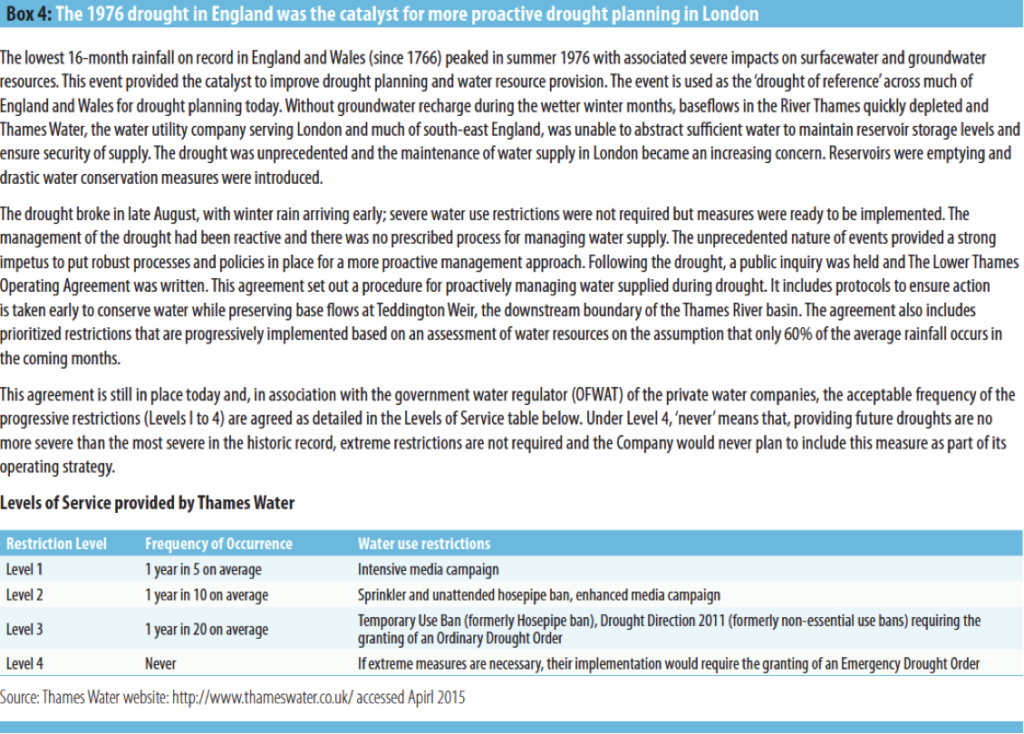
2.3. Parallel advances of relevance to drought management:
1970s to present day
Approaches to drought management have not evolved in isolation. Broader concepts influence evolution of drought management (Figure 2.3).
The most important of these concepts, and how they have shaped drought management, are discussed.
SUSTAINABLE DEVELOPMENT
In 1987, the United Nations released the Brundtland Report (WCED, 1987) that defined sustainable development as ‘development which meets the needs of the present without compromising the ability of future generations to meet their own needs’ and subsequently agreed Agenda 21, a non-binding, voluntarily action plan to support sustainable development (United Nations, 1992).
The simple concepts embedded in these documents emphasise the linkage between economic development, environmental health and social well-being (Figure 2.4). It also promotes a long-term, broadly based view of the benefits and, impacts of any decision.
Figure 2.3. Important inter-related concepts and trends that form the basis the Strategic Drought Risk Management
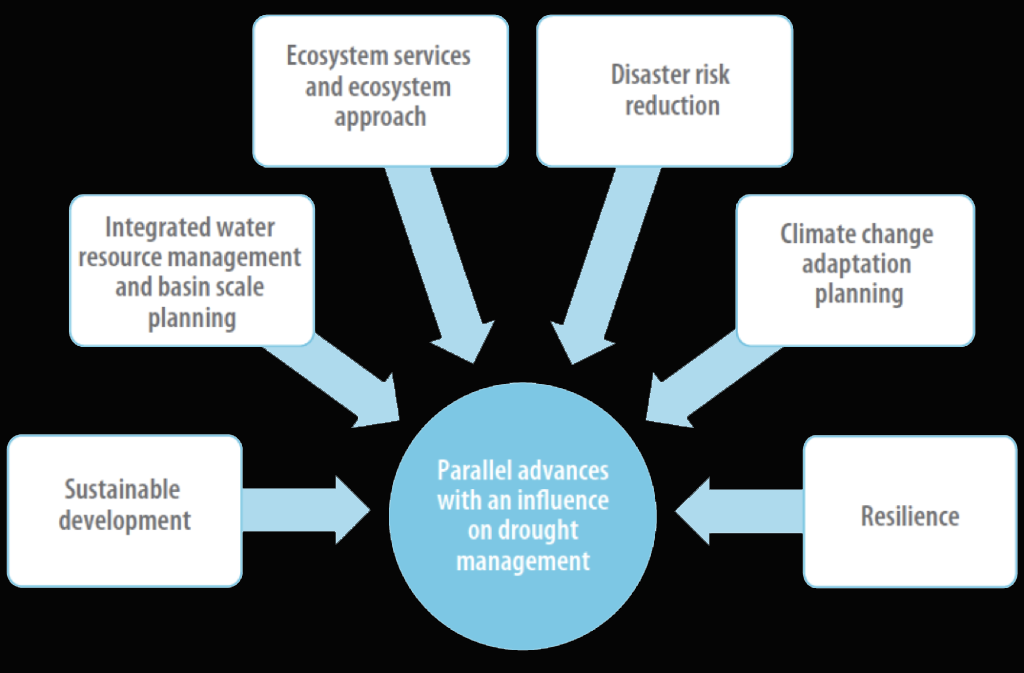
Figure 2.4. Pillars of sustainable development

In 1992, the UN Conference on Environment and Development (the Earth Summit) held in Rio de Janeiro set out a blueprint to achieve sustainable development in practice (Agenda 21).
Agenda 21 reinforces the notion of integration, and stresses a move away from sector-centred approaches to cross-sectoral coordination and integration. Broad public participation in decision making as a fundamental prerequisite for achieving sustainable development is also emphasised.
In 2000, at the Millennium Summit of the United Nations, all United Nations member states committed to supporting the principles of sustainable development and set out eight Millennium Development Goals (MDG) to be achieved by 2015:
- to eradicate extreme poverty and hunger
- to achieve universal primary education
- to promote gender equality and empower women
- to reduce child mortality
- to improve maternal health
- to combat HIV/AIDS, malaria and other diseases
- to ensure environmental sustainability
- to develop a global partnership for development.
Water, and the management of drought, is relevant to many of these goals and features in the specific targets set out under MDG 7: To ensure environmental sustainability (Box 5). A series
of Sustainable Development Goals (SDGs) (draft at the time of writing) are expected to follow-on from, and expand upon, the existing MDGs (that are due to expire at the end of 2015).
The SDGs will frame international agendas and political policies for the next 15 years to 2030. Although the SDGs are yet to be confirmed, initial proposals reinforce the importance of well managed water resources and the need to protect, restore and promote healthy ecosystems. For example, draft SDG6 specifically targets sustainable management of water:
Goal 6. Ensure access to water and sanitation for all
- by 2030, achieve universal and equitable access to safe and affordable drinking water for all
- by 2030, achieve access to adequate and equitable sanitation and hygiene for all, and end open defecation, paying special attention to the needs of women and girls and those in vulnerable situations
- by 2030, improve water quality by reducing pollution, eliminating dumping and minimising release of hazardous chemicals and materials, halving the proportion of untreated wastewater, and substantially increasing recycling and safe reuse globally
- by 2030, substantially increase water-use efficiency across all sectors and ensure sustainable withdrawals and supply of freshwater to address water scarcity, and substantially reduce the number of people suffering from water scarcity
- by 2030 implement integrated water resources management at all levels, including through transboundary cooperation as appropriate
- by 2030 protect and restore water-related ecosystems, including mountains, forests, wetlands, rivers, aquifers and lakes
- by 2030, expand international cooperation and capacity building support to developing countries in water- and sanitation-related activities and programmes, including water harvesting, desalination, water efficiency, wastewater treatment, recycling and reuse technologies
- support and strengthen the participation of local communities for improving water and sanitation management.
INTEGRATED WATER RESOURCE MANAGEMENT AND BASIN-SCALE PLANNING
The concept of Integrated Water Resources Management (IWRM) emerged in response to the recognised shortcomings of massive water resources infrastructure developed across the world between 1920 and 1970. In particular, it became increasingly clear that:
- technical engineering solutions alone would not solve complex water resource issues
- functioning freshwater ecosystems are a prerequisite to sustainable development
- without more innovative approaches the cost of water supply and waste management would continue to increase
- without a more decentralised management and greater stakeholder engagement it is difficult to deliver sustainable outcomes.
The principles of IWRM, as enshrined by the so-called Dublin Principles (ICWE, 1992), represent a move away from water resource development and emphasises environmental protection, stakeholder participation and identifies water as an economic good.
The IWRM encompasses sustainable use of water resources to support ecosystems, societies and economies.
Although progress towards the IWRM has been slow, accepted frameworks of good practice based on basin planning are starting to emerge (Pegram et al., 2013).
These frameworks provide useful lessons for managing drought risks. They highlight the need to:
- focus on maintaining critical ecosystem functions and services;
- make choices within the context of limited information and imperfect institutions;
- implement multiple management responses (including but not limited to infrastructure);
- develop basin-scale environmental management; and
- reflect future change (economic, environmental and social) within the decision making process.

ECOSYSTEM SERVICES AND AN ECOSYSTEM APPROACH
As early as the 1960s, concerns over the loss and deterioration of wetlands and their impact on people increased the profile of freshwater ecosystems and led to the Convention on Wetlands (1971), commonly known as the Ramsar Convention.
In the 1970s and 1980s the concept of ‘ecosystem services’ emerged – the many benefits human society receives from natural systems. The concept of ‘ecosystem functions’ also emerged – the
functions that give rise to these ecosystem services. These two terms provided a formal basis for recognising the importance of natural systems.
The concepts received much greater interest after the 2005 Millennium Ecosystem Assessment (MEA, 2005), an international effort to understand the societal dependence on ecosystems and assess the consequences of ecosystem change on human well-being and the scientific basis for action.
Ecosystem services now underpin an ‘ecosystem approach’ advocated by the UN Convention for Biodiversity. The ecosystem approach seeks to develop ‘a strategy for the integrated management of land, water and living resources that promotes conservation and sustainable use in an equitable way. The approach has lead to the associated has concepts of ‘ecosystems-based disaster risk reduction’ (Renaud et al., 2013) and ‘ecosystems-based adaptation’ that aim to ‘use biodiversity and ecosystem services to help people adapt to the adverse effects of climate change as part of an overall adaptation strategy’ (CBD, 2009).
Despite the international recognition of the importance of ecosystems and their role in disaster-risk reduction (Box 6), there continues to be limited progress in utilising ecosystem based approaches (Renaud et al., 2013). Drought strategies in particular fail to recognise the full range of interdependencies between human systems and freshwater ecosystems, and hence do not capitalise on the potential for the positive feedbacks between the two. Indeed, evidence from the case studies undertaken suggests that most countries have failed to develop strategies capable of managing the effects of drought on freshwater ecosystems (focusing primarily on essential needs and agricultural and industrial requirements), let alone actively promoting freshwater ecosystems to reduce drought risk.

Environmental flows
The concept of allocating a flow to the environment, a so called ‘environmental flow’, emerged in the 1970s, but evolved significantly in the early 2000s to describe the quantity, timing and quality of water flows required to sustain freshwater and estuarine ecosystems and the human livelihoods and well-being that depend on these ecosystems (Brisbane Declaration, 2007).
Today, managing water resources to ensure environmental flows are maintained is increasingly recognised as a key part of water resources management and there are many examples of progress with environmental flow policies around the world.
For example, recent revisions of China’s River Basin Master Plans aspire to introduce environmental flows across the country and restore flows to the Yellow River stands as the world’s largest scale reallocations of water.
The South African National Water Act 1998 is one of the most ambitious international attempts
to integrate environmental flows into the core of water policy reform (Le Quesne et al., 2010a).
Over the past decades, water allocation planning has evolved from making no allowance for environmental water needs, to the provision of some basic reserve for the environment, to the point where contemporary plans may now incorporate detailed environmental objectives
and management arrangements to deliver the necessary flows (Speed et al., 2013).
Although environmental flow considerations have begun to be incorporated in water resources management and river basin planning more broadly, in many cases environmental flows are still at the stage of policy and debate with little progress, even under non-drought conditions, for on-the-ground implementation (Le Quesne et al., 2010). There is, therefore, little practice in comprehensive environmental flow management during drought.
DISASTER RISK REDUCTION
From the 1950s onwards, the approach to disaster risk reduction (DRR) has progressively evolved, shifting from ‘crisis management’ (responding to major events as they happened) to a ‘preparedness’ approach (forecasting the event and taking early action to response (Figure 2.5).
Sustainable development, basin planning and ecosystems approaches have all influenced this development. For example, the ISDR and the associated Hyogo Framework for Action and Sendai Framework for DRR (Box 7) all reinforce the need to be better prepared.
Approaches to drought management have, in a limited way, echoed this change. Regional drought strategies have started to emerge that try to manage both supply and demand, before
and during a drought.
For example, the National Plan for Water Security, Australia was developed in response to the Millennium Drought and includes a more comprehensive consideration of water-related risks and their management (Box 8). In Spain, the National Water Strategy and in the US the California Drought Contingency Plan also promote being better prepared.
The economic case for being prepared is also increasingly clear. If done well, for every $1 spent on planning and preparation in the US, for example, it is estimated that $4 are saved (NIBS, 2005).
Figure 2.5. Disaster risk reduction has moved from ‘crisis management’ to ‘preparedness’


Advances in drought forecasting and warning systems have played a central role in supporting disaster risk reduction. In 1995, for example, the US established the National Drought Mitigation
Center and developed the Drought Monitor (Figure 2.6).
Since the establishment of the Drought Mitigation Center, and the publication of the first drought maps in 1999, the regionally applicable drought observatories to detect and forecast drought have become central to good drought management worldwide.
Despite such improvements, in many cases, the approach to drought management is still ‘crisis management’ (Box 9).
Figure 2.6. The categories of drought used in the USA Drought Monitor
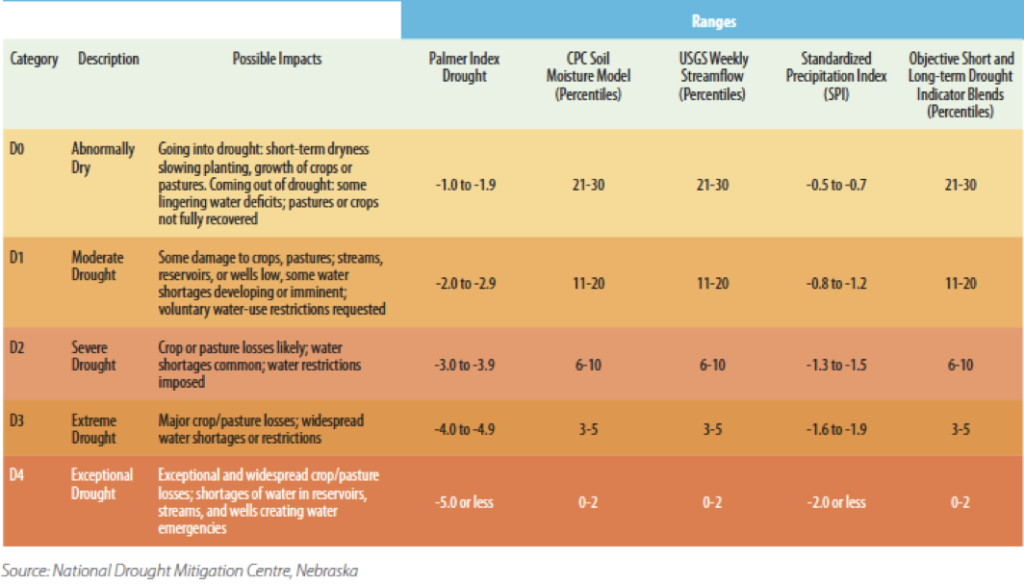
CLIMATE CHANGE ADAPTATION PLANNING
Both developed and developing countries are promoting communities that can adapt to an uncertain future. In the past 20 years the concept of adaptation planning has evolved and is
now generally accepted as an important concept in responding to climate change and other changes.
Planners are increasingly recognising the need to include preventative measures to slow down the progression of climate change (mitigation) and measures to reduce the impact of change (adaptation).
In support of this, the process of adaptive management continues to evolve but some accepted principles are starting to emerge (Sayers et al., 2012). For example, an adaptation approach:
- uses responses that do not close off or constrain future choices
- uses responses that are effective under the widest set of all plausible scenarios
- observes change through targeted monitoring and reassessed scenarios
- appropriately modifies policies, strategies and structure plans
- stresses the value of investing in ecosystems as part of climate change adaptation strategies (IPCC SpecialReport, 2012).
Drought management has been slow to embrace adaptation planning, and is typically based on two concepts that are counter to an adaptive approach.
The first is the assumption of a stationarity climate. This is changing, but slowly, and drought plans often adopt a specific historical drought event as the basis for planning.
In England, for example, privatised water companies must show they would be able to cope with a recurrence of the 1976 ‘reference drought’.
The second is using target standards of service, or levels of service, for acceptable frequency of water restrictions or other measures taken during a drought (Box 10).
As a result, the standards of service are often not flexible enough for adaptation as impacts and relative priorities emerge.


RESILIENCE:
PROMOTING A RESILIENT SOCIETY
In response to a series of major disasters (e.g. Hurricane Katrina, 2005, the India Ocean Tsunami, 2004 and, at the time of writing, the ongoing drought in California, 2010 ongoing) the concept of ‘resilience’ has emerged as a central consideration in preparing for natural hazards.
What constitutes resilience is evolving, but some agreed principles are emerging (Sayers et al., 2012):
- Resist: an ability to resist a wide range of threats, including ones that are not necessarily foreseen during the planning or design process and does not fail catastrophically when hazard events more severe than those planned for.
- Recover: an ability to recover rapidly with limited aid from a disruptive event supporting the rapid return to normality.
- Adapt: an ability to adapt to a changing environment and institutional arrangements and policies.
Resilience is not achieved in isolation. Ecosystems approaches that promote the use of biodiversity and ecosystem services to reduce natural disasters and respond to climate change are central to achieving long-term resilience.
The concept of building resilient societies has also become increasingly recognised by the DRR community and is reflected as a goal in, for example, the ISDR and the associated Hyogo and Sendai Frameworks.
Resilience concepts have also started to impact the theory, if not the practice, of drought management. In 2013, more than 300 government decision makers, development agencies and leading scientists and researchers from 87 countries came together in Geneva to discuss approaches to improving resilience to drought (Wilhite et al., 2014; Sivakumar et al., 2013).
The result reinforced the need for a change in current drought management approaches and highlighted the lack of coherent national drought management policies as a major barrier to change.
2.4. Live issues and challenges in drought management today
Drought management has evolved, and continues to evolve, in response to the drought events, advances in science and changes in philosophy as outlined in the preceding sections.
This evolution had been a chaotic process and, to date, no single blueprint for what constitutes good drought management has been agreed. There is, however, an emerging consensus over the challenges faced by modern drought managers in translating the initiatives discussed in the preceding chapter and the lessons from past drought into good, strategic management.
The most important of these challenges are summarised in Figure 2.7 and discussed below.
Figure 2.7. Summary of issues and challenges facing international practice

HOW TO PROMOTE DROUGHT RESILIENCE THROUGH MORE EFFECTIVE POLICIES AND INSTITUTIONS
The complex nature of drought means that effective actions require cooperation and coordination at all levels. This is difficult to achieve and in many countries institutions often have limited capacity to comprehensively prepare for droughts.
In some jurisdictions progressive laws are emerging. For example, the English Water Bill underlines the primary duty of water providers as ‘to ensure resilience of water supplies’ (Defra, 2012 & 2016).
Basin-scale organisations, such as river basin authorities, or national scale bodies, such as the environmental agencies, increasingly have a remit to take a strategic oversight of drought
issues.
However, existing water laws and institutions often fail to support good drought planning. The challenge is to provide a framework of water resource management that promotes a broad consideration of drought issues and management responses to:
- Promote drought resilient communities and societies: as yet a blueprint for a drought resilient society does not exist. As a result, developing a practical long-term strategy to support societies to become more drought resilient remains a challenge.
- Reform allocation and promote flexible trading: in many countries water allocations are fixed. During periods of drought this can lead to inefficient and inappropriate allocations.
- Reflect the true value of water in the choices made: many water users have little economic incentive to conserve because water is either underpriced or not priced at all.
HOW TO PROMOTE RESILIENCE THROUGH BETTER PLANNING
Failure to appropriately plan for drought can lead to expensive, sub-optimal measures when governments respond in haste during the middle of a crisis.
However, developing better plans is difficult. It presents challenges in both the planning process and determining the nature of the plan itself.
A better planning process:
- Integrates drought and water resource planning: drought management plans and national drought strategies are now routine in many countries in Europe, the US and Australia. But few plans are statutory and few are well integrated into broader river basin and wider water management planning.
- Engages a wider range of stakeholders: public bodies, private sector organisations and individuals increasingly expect to be engaged in the decisions that affect them. This engagement can be difficult because the provision of information is often asymmetrical with different stakeholders having access to different data. Given that drought management occurs in the context of both competition and collaboration between stakeholders, this asymmetry may promote mistrust of the evidence and a reluctance to act. Without agreement, significant investment can be wasted (Box 11).
- Recognises the political dimension of managing impacts of drought: the challenge for water resource managers is to ensure that political leaders make planning decisions based on the best available information about options and trade-offs.

Better plans:
Move away from crisis management: Despite the widely held desire to move away from a crisis approach to drought management towards a proactive approach, progress is slow (Box 12 and Plate 3). In part, this is due to difficulty in:
- assessing the chance of future droughts and their severity
- understanding and valuing potential impacts
- determining the relative priorities quantifying the benefits a particular action has for people, ecosystems and economy
- communicating risks and uncertainty effectively, particularly low-probability drought events.
Avoid reactive infrastructure development: Many cities have looked to improve water security through the construction of climate-resilient infrastructure. While these measures have undoubtedly resulted in more secure water supplies, they have come at a very high cost, particularly where new infrastructure has been built hastily in response to emergency conditions. For example, in Queensland, Australia a desalination plant and recycled water treatment plant were both constructed during the height of the Millennium Drought (2007-12) at a combined cost of A$3.8 billion (QAO, 2013). A recent review was critical of the process for deciding to proceed with construction and found that better planning may have avoided such drastic and costly action. The review also found that a thorough and rigorous assessment of all costs and of the social, economic and environmental benefits in all likely modes of operation should have been undertaken (QAO, 2013).
Accepts that future drought may be more severe than historical drought: In most cases, drought plans continue to be based on a reference drought. In the US, for example, the Dust Bowl drought (1934–1939) is often used as the reference drought. In England, the drought of 1976 is used by regulators to confirm the adequacy of water authorities’ drought planning. The use of historical events as the basis for planning is starting to be challenged. More extreme drought than that experienced in the past is possible and probable in the medium to longer term due to the stochastic nature of drought events and, with the increasing impact of climate change, past events are unlikely to be an appropriate analogy for future conditions.
Recognise the future as uncertain and plan accordingly: Data on drought hazards and impacts, and how these might change in the future are very uncertain. Yet within current approaches there is an underlying assumption of ‘perfect knowledge’ and a reluctance to actively manage uncertainty. Non-stationarity in climate and socio-economic complexities add to the difficulties and it is impossible to predict longer-term changes in drought risk with any degree of precision. This high level of uncertainty can lead to inaction. Understanding how to embrace this uncertainty within the decision making process is an important challenge.
HOW TO PROMOTE ECOSYSTEM APPROACHES AND GREEN INFRASTRUCTURE WITHIN
DROUGHT MANAGEMENT
Despite the international recognition of ecosystem-based approaches and recognition of the advances of green infrastructure (GI) for DRR, there has been limited progress in applying ecosystem approaches and realising the benefits at scale; the majority of ecosystem approaches have only been implemented at project or pilot-demonstration levels (Renaud et al., 2013). This seems to be the case in drought management where approaches have often failed to recognise the interdependencies between human systems and freshwater ecosystems and, as a result, have not capitalised on the potential for the positive feedbacks between the two.
The evidence from the case studies completed for this book suggest that most countries have failed to develop strategies capable of managing the effects of drought on ecosystems, let alone actively promote freshwater ecosystems to reduce drought risk. This seems particularly the case in catchments where human disturbances have reduced the natural resistance and resilience of freshwater ecosystems, and where the demand for consumptive water use is high and rising. For example, the Millennium Drought in Australia had detrimental effects on critical ecosystems in the heavily abstracted Murray–Darling Basin.
Seeking to change this situation presents a number of significant challenges:
Promoting the take-up of ecosystem approaches: Ecosystem-based approaches to water resource management are increasingly being accepted in theory that has not yet translated to practice in water resource management generally or in drought risk management more specifically. Often, protecting ecosystems and biodiversity is a low priority in droughts, due to poor valuation of ecosystems, a disconnect between expert communities and policy sectors, difficult trade-offs between short-term needs and long-term needs in moments of crisis, and difficulty in securing environmental flows.
Valuing the benefits derived from freshwater ecosystems: Bringing protection of freshwater ecosystems to the drought risk management agenda requires an appreciation of the benefits these systems bring to society. Ecosystem valuation approaches transparently assess ecosystem services and therefore help to provide robust arguments for protecting and using them in drought risk management. However, despite the increasing acceptance of ecosystem valuation approaches (both monetary and non-monetary), the value freshwater ecosystems bring to society is poorly reflected in decisions about how they are used and managed. Failure to account for the real value of natural systems and their services is thought to be a significant factor in their continuing loss and degradation (TEEB, 2010).
Securing environmental flows during a drought to protect priority ecosystems: Perceived conflicts between the needs of nature and the needs of people are at their most acute during a drought. It is often hard to mount a compelling case that water should be set aside for the natural environment when the impact on a business or community is urgent. In Spain, the regulatory framework (Instruction for Hydrological Planning, 2008) allows a less demanding environmental flows regime as long as certain conditions are met and fish habitat availability remains above a 25% threshold (lower than the 50–80% threshold that must be respected during non-drought conditions, although this exception does not include protected areas). Despite these concessions, maintaining even reduced environmental flows is difficult; for example, the draft 2016–2021 Guadalquivir River Basin Management Plan recognises that 31% of the minimum flows and 88% of the maximum flows have not been respected in the recent years (Benítez anz and Schmidt, 2012). This example highlights the increasingly difficult challenge of maintaining an inclusive and constructive debate to agree water allocations (and restriction priorities) as a drought extends, often leading to poor outcomes for all.

WHEN TO TAKE ACTION
Ever since the establishment of the US Drought Mitigation Center in the mid-1990s, significant effort has been directed towards improving drought monitoring and forecasting. Today, many countries have some form of monitoring and provide warnings, reflecting the drought conditions ‘now’ or a short time into the future. There are also ongoing efforts to provide early warning at a global scale.
Drought, however, reveals itself in many different ways. Detecting the gradual onset of drought in a way that is useful for individual, community, basin and national decision makers before the drought becomes a crisis, is still problematic and significant further advances are needed for information that is better directed towards the needs of decisions makers, and is honest about uncertainty.
Challenges include:
- Monitoring and forecasting the ‘right’ indicators: Various countries, most notably Spain and the US, routinely monitor a range of indicators, often focusing on meteorological data, blue-water data (e.g. reservoir levels) and green-water data (e.g. soil moisture). Determining the most meaningful indicators for specific contexts is an area of debate and research.
- Extending the period of credible forecasts: Despite significant advances in short-term forecasting of drought driving events and the hydrological response, little attention is given to forecasting how the developing drought hazard may lead to impacts in the coming weeks, months or years. This lack of foresight makes decision making difficult and can lead to acting too early and wasting resources, or to acting too late. The lack of ability to forecast droughts more than three to six months in advance constrains the implementation of mitigation and response measures. Significant research needs to be devoted to understanding the causal factors and teleconnections that drive drought development.
- Declaring the onset and cessation of drought: The onset of a drought is typically declared through a process based on judgment and debate in the midst of the crisis itself. Once a drought is declared, water restrictions can be implemented and, in many cases, legally enforced. In some regions (England, Australia and some parts of the US, such as California) drought management plan supports the process of ‘declaration’ and set out in detail who should be consulted, the ultimate arbiter of the drought, and the evidence that should be used to declare the drought. Although a drought management plan aids openness and encourages buy-in from stakeholders, the declaration of drought continues to be seen as a political choice, biased towards a limited number of stakeholders, typically from farming and industry. Wider groups of stakeholders, especially those representing environmental interests, are often excluded from the declaration process. In many other countries, where drought management plan do not exist, the process of declaration is more aligned to a ‘crisis’ situation with a civil protection agency (or its equivalent) having the power to ‘declare’, and ‘deactivate’, the drought declaration with limited understanding of the risks and relevant stakeholders.
- Implementing water restrictions: Water restrictions are an effective measure for reducing demand during periods of drought and typically form a key element of all drought plans. The reality of a drought, however, is invariably different to that planned for. Planning for a greater range of drought scenarios and embedding an adaptive, but open and transparent, process of adjustment as the drought extends is a challenge.
- Delivering drought relief and the potential for perverse incentives: Drought relief is often given first to those who have not adequately planned adequately for drought. Those that have planned often experience reduced losses and perhaps are not eligible for drought relief. This is further evidence of the need to move away from the crisis management approach.
- Taking the opportunity to promote positive, longer term changes without committing to poorly planned infrastructure: Droughts can be an opportunity to put longer-term demand side measures in place. For example, the drought in southern Queensland significantly raised awareness of drought issues and changed behaviours, leading to a significant reduction in per capita daily water consumption. Drought events can also be catalyst for more strategic action, as highlighted through the California droughts of the 1970s and the drive to establish a more strategic approach to drought management through the establishment of the National Drought Mitigation Center. The aftermath of a drought often provides a key opportunity to break the ‘hydro-illogical cycle’. In general, however, making significant decisions at the height of drought is a high-risk strategy; this is a criticism of the response to the 1991–95 drought in Spain (Box 13).


HOW TO BEST AID RECOVERY AND WHEN TO END EMERGENCY MEASURES
Managing drought does not stop when the rains start. Understanding how best to aid recovery and transition to non-drought conditions presents a number of challenges:
Stopping illegal or temporary abstractions: There is a perception that illegal (or unregulated) abstractions are common in many countries. Such abstractions are particularly problematic during periods of drought and can make allocation planning difficult and recovery slow. Revoking temporary abstraction agreements can be problematic as water users
Relaxing temporary restrictions: Restrictions imposed during a drought are usually temporary. There may be a temptation to make temporary measures permanent to reduce long-term demand. However, this means that temporary restrictions are no longer available to managing the supply-demand balance during drought (Chong et al., 2009).
Distributing financial compensation: Financial compensation for those affected by drought is widely used and accepted to promote recovery. In the US, for example, farmers increasingly turn to the Federal Crop Insurance Corporation to manage weather-related risks, including crop loss due to drought. Financial compensation has also been a feature of drought responses elsewhere (Box 14). This approach is not without problems as it can be difficult to encourage best practice water management. Questions of who should pay and who should benefit, and the mechanism to pay compensation through are debated.
Recovery of freshwater ecosystems: During drought, water for environmental purposes can be the first to be affected. Curtailing environmental flows impacts freshwater ecosystem function and its ability to deliver services for key economic sectors and to sustain livelihoods and well-being. It is crucial to reinstate environmental flows as soon as water reserves increase to viable levels. Reinstating environmental flows may require abstraction restrictions and storage operation rules in place until water reserves and river flows return to their usual levels.
* * *
Citation
Sayers, P.B., Li Yuanyuan, Moncrieff, C, Li Jianqiang, Tickner, D., Xu Xiangyu, Speed, R., Li Aihua, Lei Gang, Qiu Bing, Wei Yu and Pegram G. (2016) Drought risk management: A strategic approach. Published by UNESCO, Paris on behalf of WWF.
Published in 2016 by the United Nations Educational, Scientific and Cultural Organization 7, place de Fontenoy, 75352 Paris 07 SP, France © UNESCO 2016
* * *
For further information or to arrange an initial meeting (in person or via Zoom) please contact:
Gianluca Di Caro
Chief Executive Officer
S.Y. Drought Management, a division of S.Y. Capital Holdings Limited
Mobile/WhatsApp/BOTIM (UK): +44 (0)7789 364702
Phone: +44 (0)20 8202 8224
Mobile/WhatsApp/BOTIM (Saudi Arabia) +966 56 674 0363
E.Mail: office@droughtmanagement.uk
E.Mail: gianluca@sycapital.uk